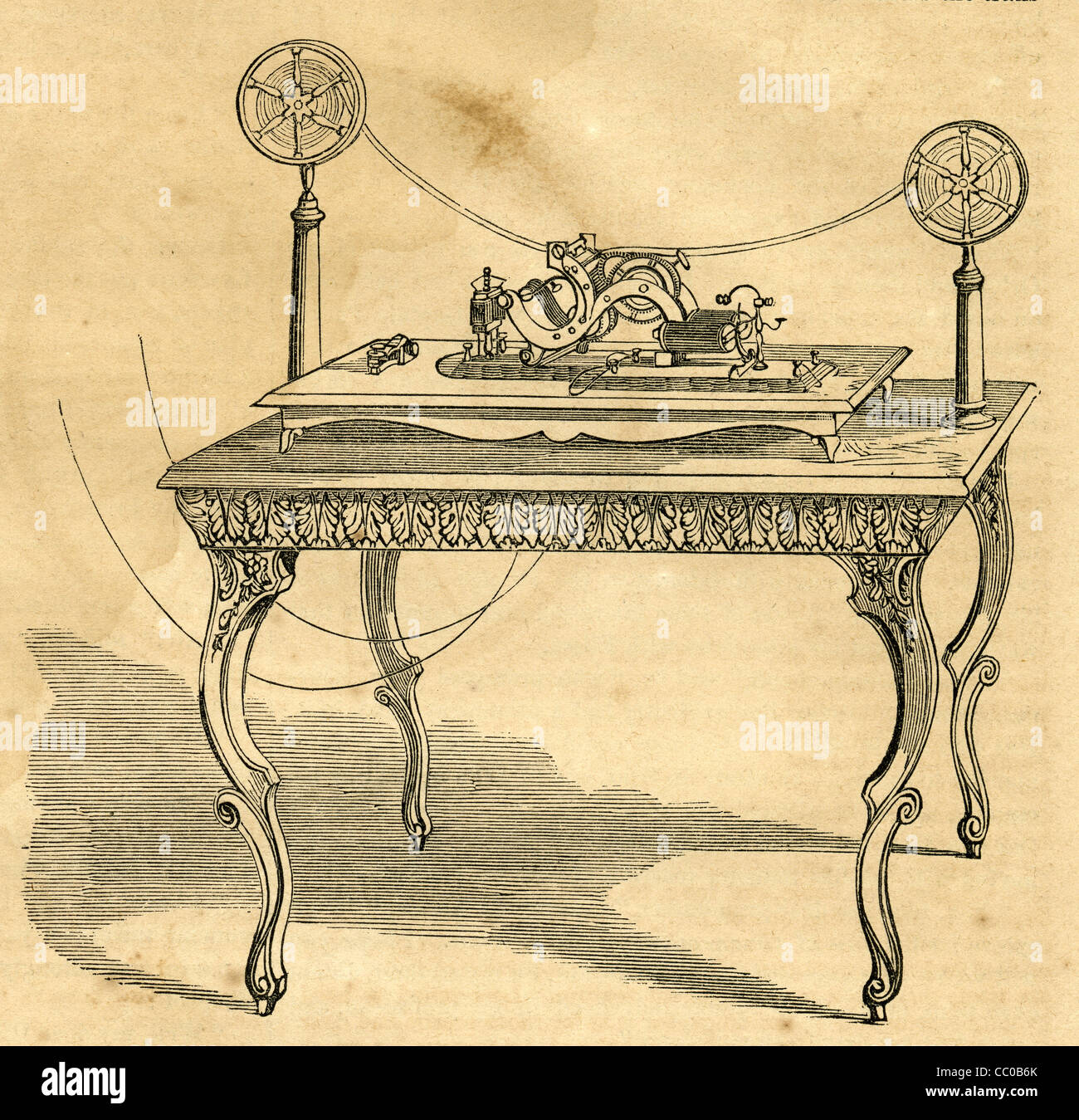Quick filters:
Telegraph machine 1800s Stock Photos and Images
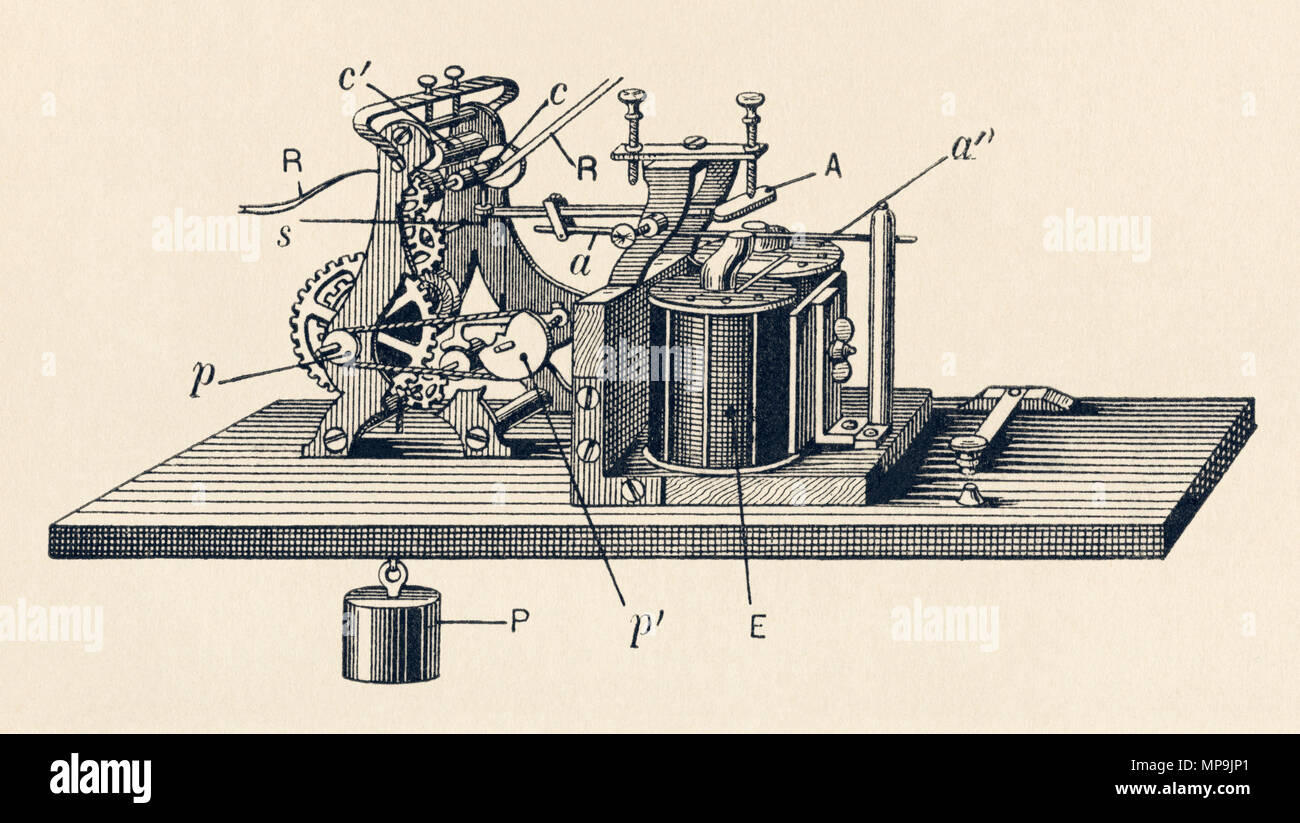 Morse's first telegraph apparatus. Woodcut Stock Photohttps://www.alamy.com/image-license-details/?v=1https://www.alamy.com/morses-first-telegraph-apparatus-woodcut-image185838409.html
Morse's first telegraph apparatus. Woodcut Stock Photohttps://www.alamy.com/image-license-details/?v=1https://www.alamy.com/morses-first-telegraph-apparatus-woodcut-image185838409.htmlRMMP9JP1–Morse's first telegraph apparatus. Woodcut
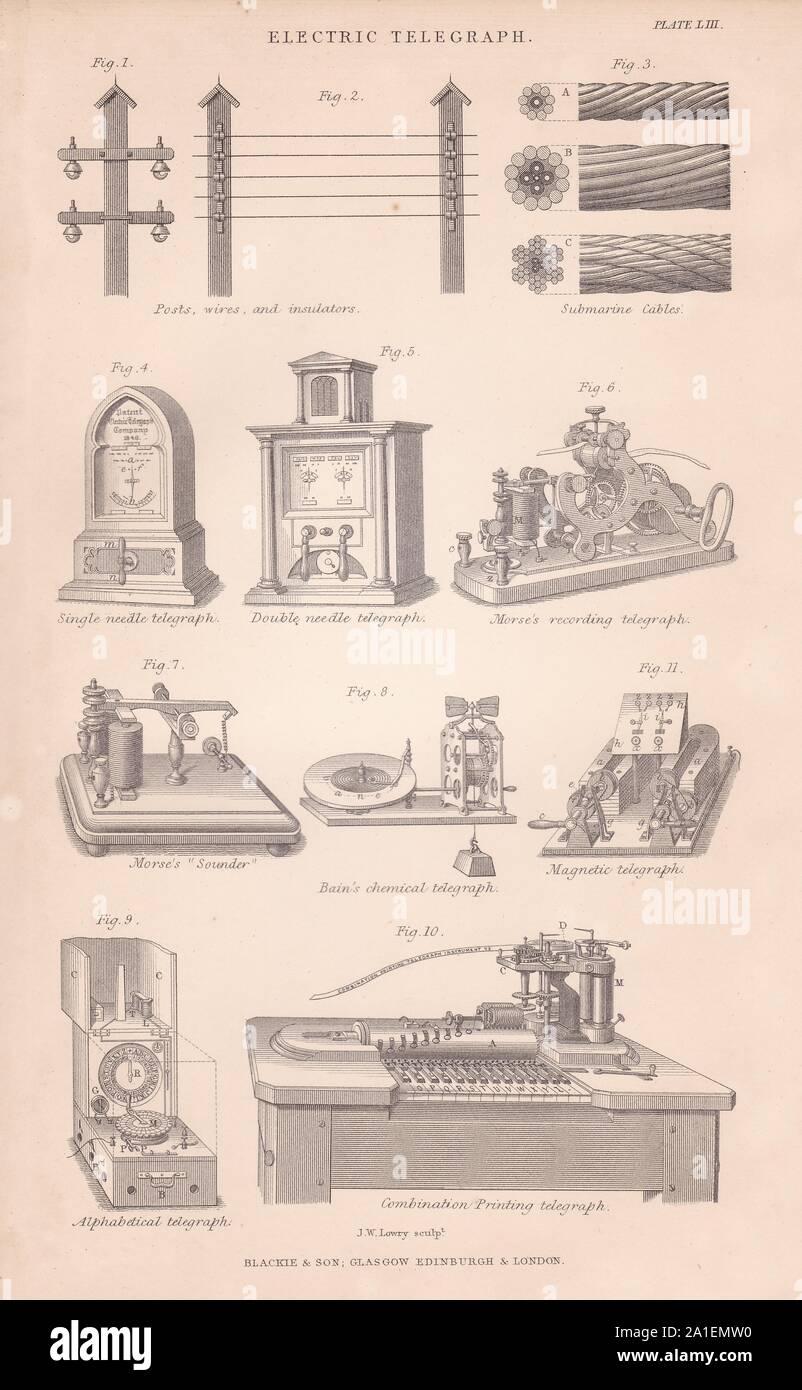 Book plate of Electric Telegraph. Stock Photohttps://www.alamy.com/image-license-details/?v=1https://www.alamy.com/book-plate-of-electric-telegraph-image327935356.html
Book plate of Electric Telegraph. Stock Photohttps://www.alamy.com/image-license-details/?v=1https://www.alamy.com/book-plate-of-electric-telegraph-image327935356.htmlRF2A1EMW0–Book plate of Electric Telegraph.
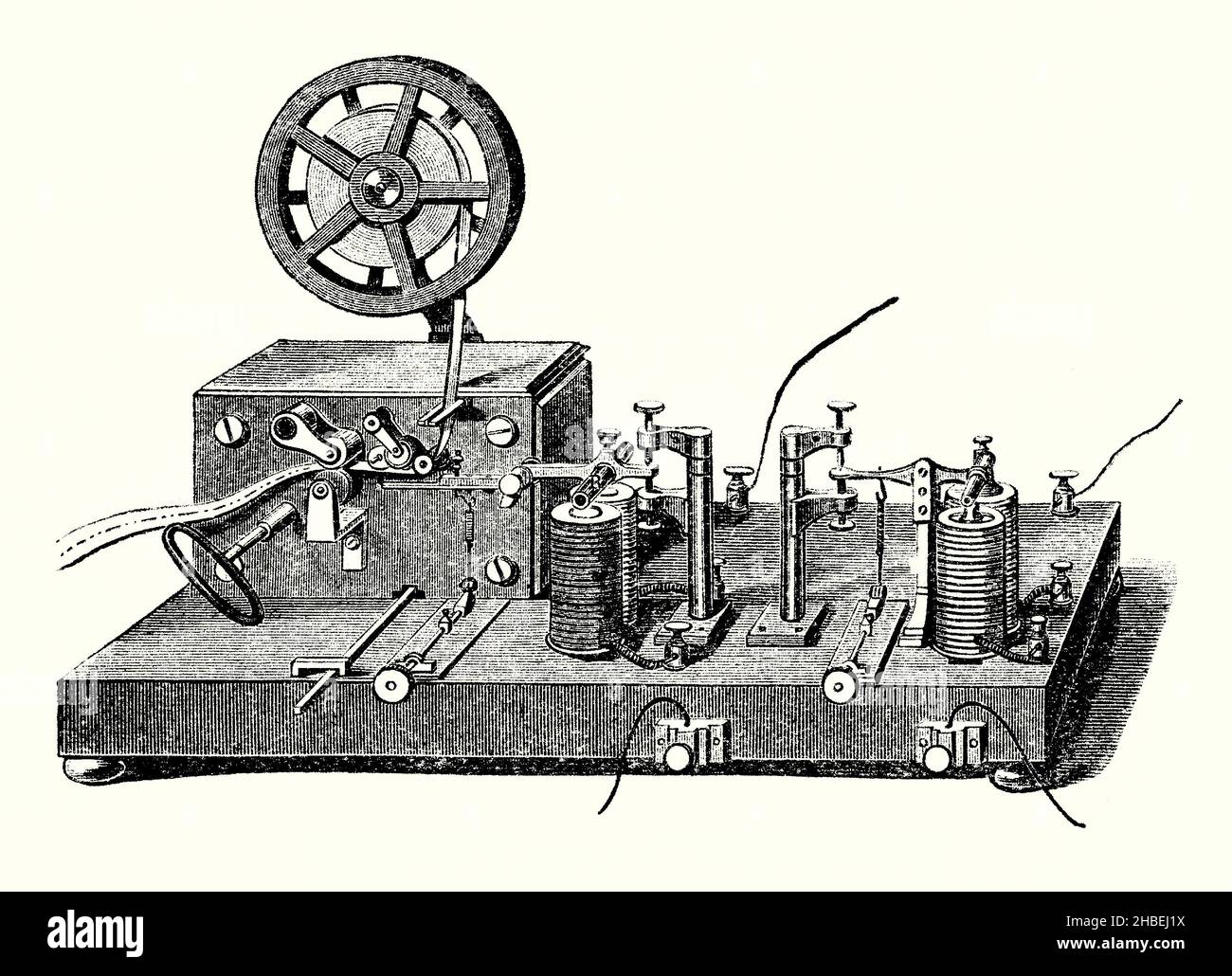 An old engraving of Morse Recording Telegraph of the 1830s. It is from a Victorian book of the 1890s on discoveries and inventions during the 1800s. American Samuel Morse (1791–1872) independently developed and patented a recording electric telegraph in 1837. Morse's assistant Alfred Vail developed an instrument that was called the register for recording the received messages. It embossed dots and dashes on a moving paper tape by a stylus (centre left) which was operated by an electromagnet. The tape is fed from a spool by a clockwork motor (left). Stock Photohttps://www.alamy.com/image-license-details/?v=1https://www.alamy.com/an-old-engraving-of-morse-recording-telegraph-of-the-1830s-it-is-from-a-victorian-book-of-the-1890s-on-discoveries-and-inventions-during-the-1800s-american-samuel-morse-17911872-independently-developed-and-patented-a-recording-electric-telegraph-in-1837-morses-assistant-alfred-vail-developed-an-instrument-that-was-called-the-register-for-recording-the-received-messages-it-embossed-dots-and-dashes-on-a-moving-paper-tape-by-a-stylus-centre-left-which-was-operated-by-an-electromagnet-the-tape-is-fed-from-a-spool-by-a-clockwork-motor-left-image454552278.html
An old engraving of Morse Recording Telegraph of the 1830s. It is from a Victorian book of the 1890s on discoveries and inventions during the 1800s. American Samuel Morse (1791–1872) independently developed and patented a recording electric telegraph in 1837. Morse's assistant Alfred Vail developed an instrument that was called the register for recording the received messages. It embossed dots and dashes on a moving paper tape by a stylus (centre left) which was operated by an electromagnet. The tape is fed from a spool by a clockwork motor (left). Stock Photohttps://www.alamy.com/image-license-details/?v=1https://www.alamy.com/an-old-engraving-of-morse-recording-telegraph-of-the-1830s-it-is-from-a-victorian-book-of-the-1890s-on-discoveries-and-inventions-during-the-1800s-american-samuel-morse-17911872-independently-developed-and-patented-a-recording-electric-telegraph-in-1837-morses-assistant-alfred-vail-developed-an-instrument-that-was-called-the-register-for-recording-the-received-messages-it-embossed-dots-and-dashes-on-a-moving-paper-tape-by-a-stylus-centre-left-which-was-operated-by-an-electromagnet-the-tape-is-fed-from-a-spool-by-a-clockwork-motor-left-image454552278.htmlRM2HBEJ1X–An old engraving of Morse Recording Telegraph of the 1830s. It is from a Victorian book of the 1890s on discoveries and inventions during the 1800s. American Samuel Morse (1791–1872) independently developed and patented a recording electric telegraph in 1837. Morse's assistant Alfred Vail developed an instrument that was called the register for recording the received messages. It embossed dots and dashes on a moving paper tape by a stylus (centre left) which was operated by an electromagnet. The tape is fed from a spool by a clockwork motor (left).
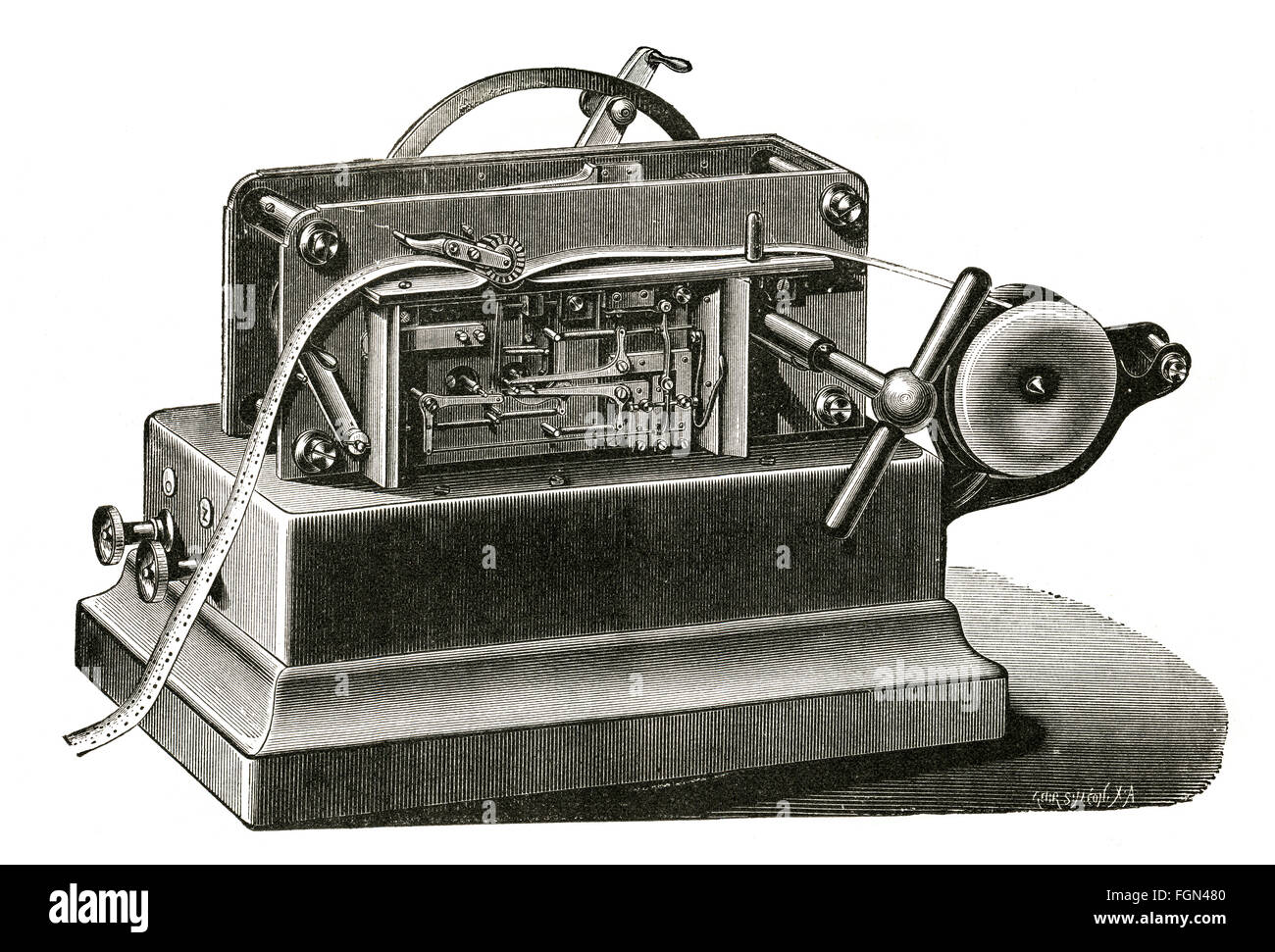 Antique 1877 engraving, Wheatstone's Automatic Telegraph, now employed by the Postal Telegraph Department of Great Britain. Stock Photohttps://www.alamy.com/image-license-details/?v=1https://www.alamy.com/stock-photo-antique-1877-engraving-wheatstones-automatic-telegraph-now-employed-96350688.html
Antique 1877 engraving, Wheatstone's Automatic Telegraph, now employed by the Postal Telegraph Department of Great Britain. Stock Photohttps://www.alamy.com/image-license-details/?v=1https://www.alamy.com/stock-photo-antique-1877-engraving-wheatstones-automatic-telegraph-now-employed-96350688.htmlRMFGN480–Antique 1877 engraving, Wheatstone's Automatic Telegraph, now employed by the Postal Telegraph Department of Great Britain.
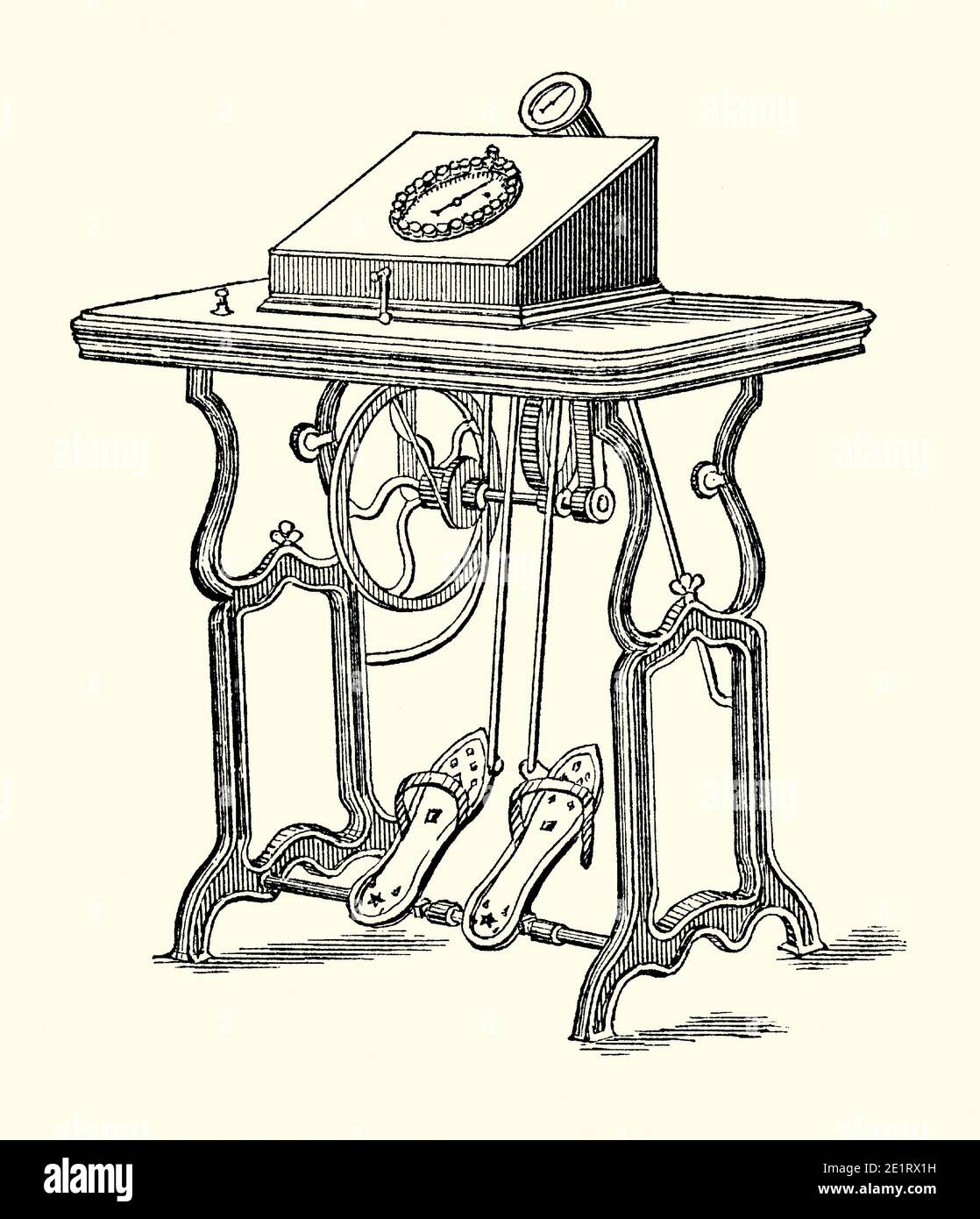 An old engraving of a Victorian ‘alarm’ dial-telegraph station. It is from a mechanical engineering book of the 1880s. This electro-magnetic device is powered by the foot treadle. This machine would be connected to similar machines within a building or compound. With the dial’s needle in the vertical position it is receive mode. Any incoming message received shows on the upper, viewing dial. This could indicate messages such as ‘fire’, ‘thieves’, ‘door not locked’ or similar. The main dial can be turned to various set positions to transmit similar signals. Stock Photohttps://www.alamy.com/image-license-details/?v=1https://www.alamy.com/an-old-engraving-of-a-victorian-alarm-dial-telegraph-station-it-is-from-a-mechanical-engineering-book-of-the-1880s-this-electro-magnetic-device-is-powered-by-the-foot-treadle-this-machine-would-be-connected-to-similar-machines-within-a-building-or-compound-with-the-dials-needle-in-the-vertical-position-it-is-receive-mode-any-incoming-message-received-shows-on-the-upper-viewing-dial-this-could-indicate-messages-such-as-fire-thieves-door-not-locked-or-similar-the-main-dial-can-be-turned-to-various-set-positions-to-transmit-similar-signals-image396978445.html
An old engraving of a Victorian ‘alarm’ dial-telegraph station. It is from a mechanical engineering book of the 1880s. This electro-magnetic device is powered by the foot treadle. This machine would be connected to similar machines within a building or compound. With the dial’s needle in the vertical position it is receive mode. Any incoming message received shows on the upper, viewing dial. This could indicate messages such as ‘fire’, ‘thieves’, ‘door not locked’ or similar. The main dial can be turned to various set positions to transmit similar signals. Stock Photohttps://www.alamy.com/image-license-details/?v=1https://www.alamy.com/an-old-engraving-of-a-victorian-alarm-dial-telegraph-station-it-is-from-a-mechanical-engineering-book-of-the-1880s-this-electro-magnetic-device-is-powered-by-the-foot-treadle-this-machine-would-be-connected-to-similar-machines-within-a-building-or-compound-with-the-dials-needle-in-the-vertical-position-it-is-receive-mode-any-incoming-message-received-shows-on-the-upper-viewing-dial-this-could-indicate-messages-such-as-fire-thieves-door-not-locked-or-similar-the-main-dial-can-be-turned-to-various-set-positions-to-transmit-similar-signals-image396978445.htmlRM2E1RX1H–An old engraving of a Victorian ‘alarm’ dial-telegraph station. It is from a mechanical engineering book of the 1880s. This electro-magnetic device is powered by the foot treadle. This machine would be connected to similar machines within a building or compound. With the dial’s needle in the vertical position it is receive mode. Any incoming message received shows on the upper, viewing dial. This could indicate messages such as ‘fire’, ‘thieves’, ‘door not locked’ or similar. The main dial can be turned to various set positions to transmit similar signals.
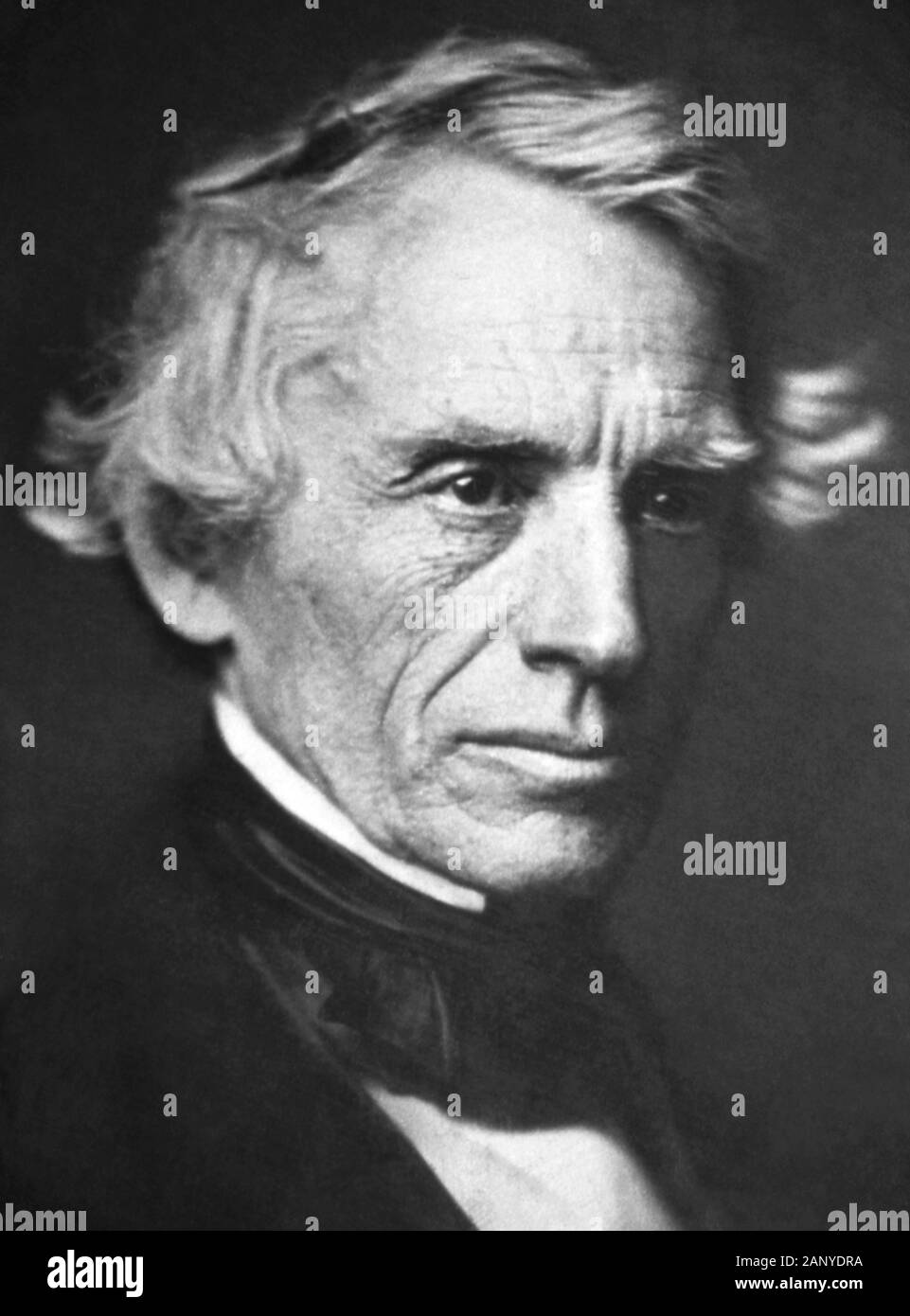 Vintage portrait photo of American painter and inventor Samuel F B Morse (1791 – 1872) – a pioneer in the development of the electric telegraph and co-creator of Morse Code. Daguerreotype photo circa 1845. Stock Photohttps://www.alamy.com/image-license-details/?v=1https://www.alamy.com/vintage-portrait-photo-of-american-painter-and-inventor-samuel-f-b-morse-1791-1872-a-pioneer-in-the-development-of-the-electric-telegraph-and-co-creator-of-morse-code-daguerreotype-photo-circa-1845-image340508318.html
Vintage portrait photo of American painter and inventor Samuel F B Morse (1791 – 1872) – a pioneer in the development of the electric telegraph and co-creator of Morse Code. Daguerreotype photo circa 1845. Stock Photohttps://www.alamy.com/image-license-details/?v=1https://www.alamy.com/vintage-portrait-photo-of-american-painter-and-inventor-samuel-f-b-morse-1791-1872-a-pioneer-in-the-development-of-the-electric-telegraph-and-co-creator-of-morse-code-daguerreotype-photo-circa-1845-image340508318.htmlRM2ANYDRA–Vintage portrait photo of American painter and inventor Samuel F B Morse (1791 – 1872) – a pioneer in the development of the electric telegraph and co-creator of Morse Code. Daguerreotype photo circa 1845.
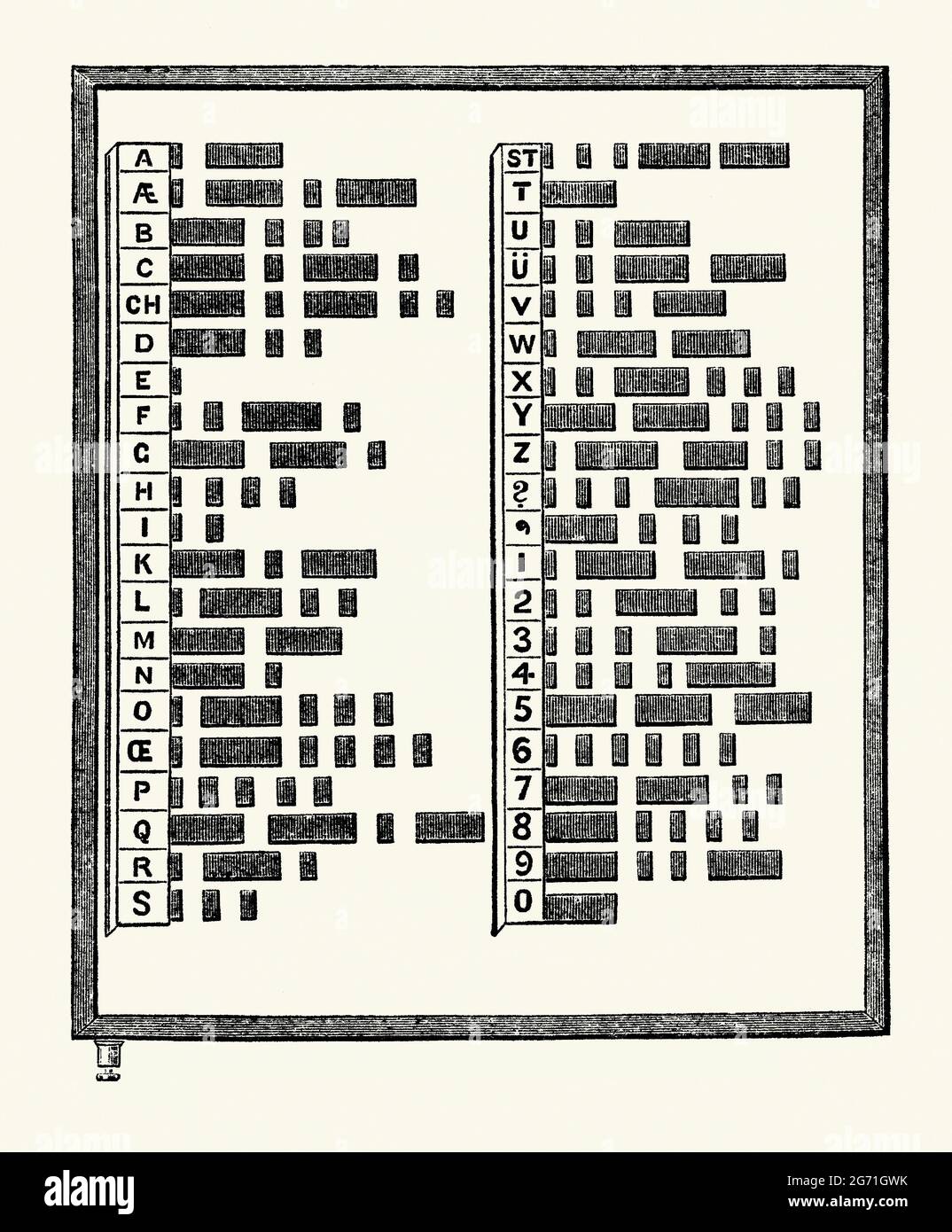 An old engraving of a Morse transmitting plate from the Victorian era. It is from a book of the 1890s on discoveries and inventions during the 1800s. Morse code is a method used in telecommunication to encode text characters as sequences of two different signal durations called dots and dashes (dits and dahs). The code is named after American Samuel Morse, one of the inventors of the telegraph. It was first used in the 1840s. International Morse Code (Continental Morse Code) of 1865 encodes the 26 alphabet letters, one non-Latin letter, numerals, punctuation and procedural signals (prosigns). Stock Photohttps://www.alamy.com/image-license-details/?v=1https://www.alamy.com/an-old-engraving-of-a-morse-transmitting-plate-from-the-victorian-era-it-is-from-a-book-of-the-1890s-on-discoveries-and-inventions-during-the-1800s-morse-code-is-a-method-used-in-telecommunication-to-encode-text-characters-as-sequences-of-two-different-signal-durations-called-dots-and-dashes-dits-and-dahs-the-code-is-named-after-american-samuel-morse-one-of-the-inventors-of-the-telegraph-it-was-first-used-in-the-1840s-international-morse-code-continental-morse-code-of-1865-encodes-the-26-alphabet-letters-one-non-latin-letter-numerals-punctuation-and-procedural-signals-prosigns-image434597007.html
An old engraving of a Morse transmitting plate from the Victorian era. It is from a book of the 1890s on discoveries and inventions during the 1800s. Morse code is a method used in telecommunication to encode text characters as sequences of two different signal durations called dots and dashes (dits and dahs). The code is named after American Samuel Morse, one of the inventors of the telegraph. It was first used in the 1840s. International Morse Code (Continental Morse Code) of 1865 encodes the 26 alphabet letters, one non-Latin letter, numerals, punctuation and procedural signals (prosigns). Stock Photohttps://www.alamy.com/image-license-details/?v=1https://www.alamy.com/an-old-engraving-of-a-morse-transmitting-plate-from-the-victorian-era-it-is-from-a-book-of-the-1890s-on-discoveries-and-inventions-during-the-1800s-morse-code-is-a-method-used-in-telecommunication-to-encode-text-characters-as-sequences-of-two-different-signal-durations-called-dots-and-dashes-dits-and-dahs-the-code-is-named-after-american-samuel-morse-one-of-the-inventors-of-the-telegraph-it-was-first-used-in-the-1840s-international-morse-code-continental-morse-code-of-1865-encodes-the-26-alphabet-letters-one-non-latin-letter-numerals-punctuation-and-procedural-signals-prosigns-image434597007.htmlRM2G71GWK–An old engraving of a Morse transmitting plate from the Victorian era. It is from a book of the 1890s on discoveries and inventions during the 1800s. Morse code is a method used in telecommunication to encode text characters as sequences of two different signal durations called dots and dashes (dits and dahs). The code is named after American Samuel Morse, one of the inventors of the telegraph. It was first used in the 1840s. International Morse Code (Continental Morse Code) of 1865 encodes the 26 alphabet letters, one non-Latin letter, numerals, punctuation and procedural signals (prosigns).
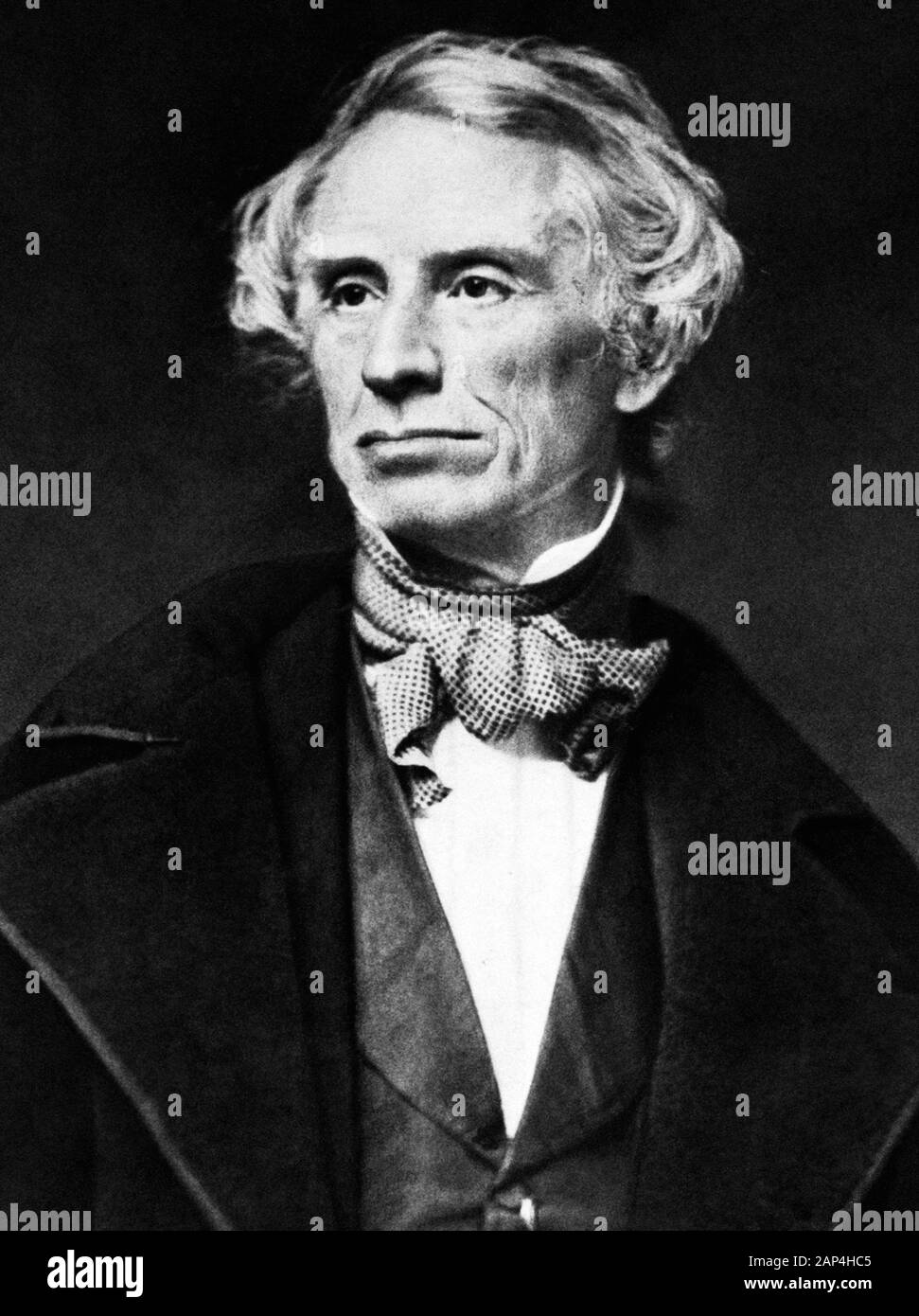 Vintage portrait photo of American painter and inventor Samuel F B Morse (1791 – 1872) – a pioneer in the development of the electric telegraph and co-creator of Morse Code. Photo circa 1855 by Mathew B Brady. Stock Photohttps://www.alamy.com/image-license-details/?v=1https://www.alamy.com/vintage-portrait-photo-of-american-painter-and-inventor-samuel-f-b-morse-1791-1872-a-pioneer-in-the-development-of-the-electric-telegraph-and-co-creator-of-morse-code-photo-circa-1855-by-mathew-b-brady-image340620901.html
Vintage portrait photo of American painter and inventor Samuel F B Morse (1791 – 1872) – a pioneer in the development of the electric telegraph and co-creator of Morse Code. Photo circa 1855 by Mathew B Brady. Stock Photohttps://www.alamy.com/image-license-details/?v=1https://www.alamy.com/vintage-portrait-photo-of-american-painter-and-inventor-samuel-f-b-morse-1791-1872-a-pioneer-in-the-development-of-the-electric-telegraph-and-co-creator-of-morse-code-photo-circa-1855-by-mathew-b-brady-image340620901.htmlRM2AP4HC5–Vintage portrait photo of American painter and inventor Samuel F B Morse (1791 – 1872) – a pioneer in the development of the electric telegraph and co-creator of Morse Code. Photo circa 1855 by Mathew B Brady.
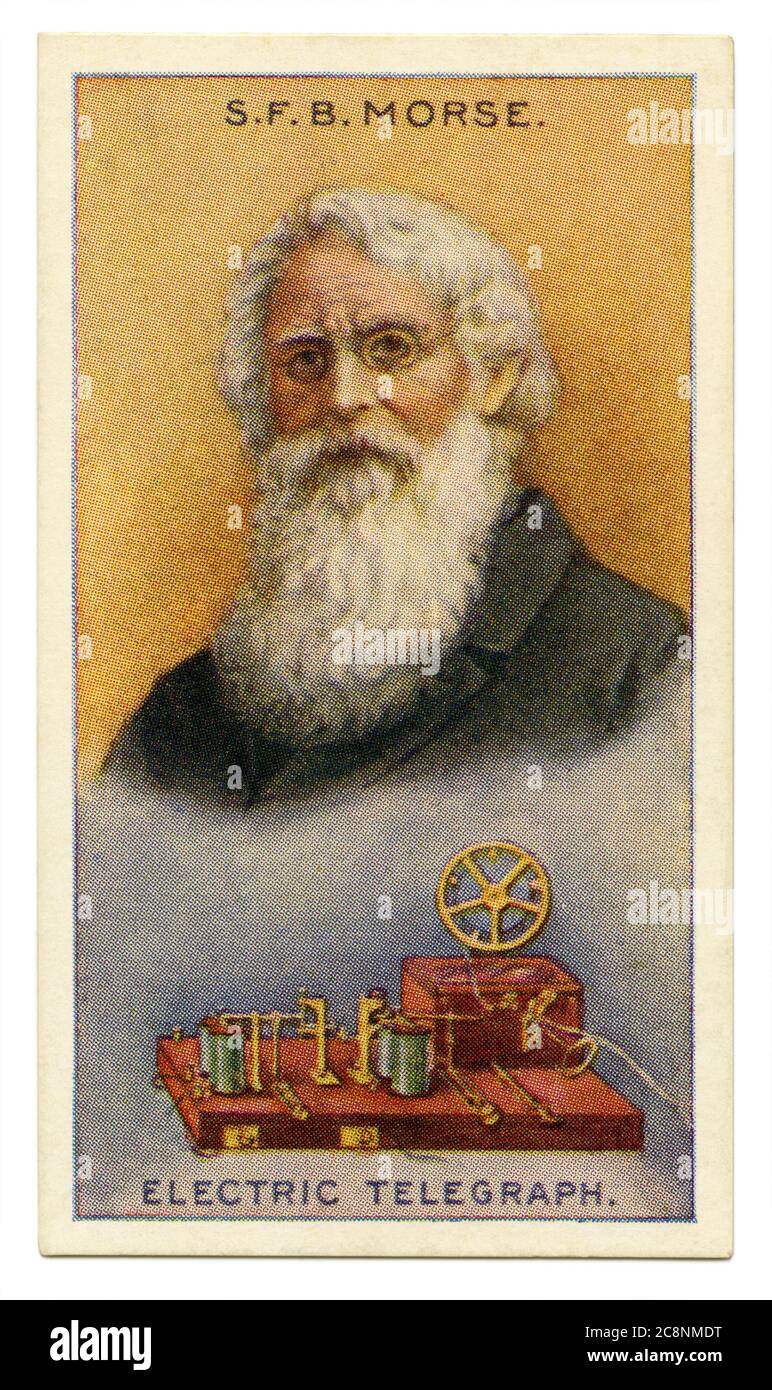 An old cigarette card (c. 1929) with a portrait of Samuel Finley Breese Morse (1791–1872) and an illustration of his electric telegraph. Morse was an American inventor and painter. After having established his reputation as a portrait painter, in his middle age Morse contributed to the invention of a single-wire telegraph system based on European telegraphs. He was a co-developer of Morse code and helped to develop the commercial use of telegraphy. Stock Photohttps://www.alamy.com/image-license-details/?v=1https://www.alamy.com/an-old-cigarette-card-c-1929-with-a-portrait-of-samuel-finley-breese-morse-17911872-and-an-illustration-of-his-electric-telegraph-morse-was-an-american-inventor-and-painter-after-having-established-his-reputation-as-a-portrait-painter-in-his-middle-age-morse-contributed-to-the-invention-of-a-single-wire-telegraph-system-based-on-european-telegraphs-he-was-a-co-developer-of-morse-code-and-helped-to-develop-the-commercial-use-of-telegraphy-image366812036.html
An old cigarette card (c. 1929) with a portrait of Samuel Finley Breese Morse (1791–1872) and an illustration of his electric telegraph. Morse was an American inventor and painter. After having established his reputation as a portrait painter, in his middle age Morse contributed to the invention of a single-wire telegraph system based on European telegraphs. He was a co-developer of Morse code and helped to develop the commercial use of telegraphy. Stock Photohttps://www.alamy.com/image-license-details/?v=1https://www.alamy.com/an-old-cigarette-card-c-1929-with-a-portrait-of-samuel-finley-breese-morse-17911872-and-an-illustration-of-his-electric-telegraph-morse-was-an-american-inventor-and-painter-after-having-established-his-reputation-as-a-portrait-painter-in-his-middle-age-morse-contributed-to-the-invention-of-a-single-wire-telegraph-system-based-on-european-telegraphs-he-was-a-co-developer-of-morse-code-and-helped-to-develop-the-commercial-use-of-telegraphy-image366812036.htmlRM2C8NMDT–An old cigarette card (c. 1929) with a portrait of Samuel Finley Breese Morse (1791–1872) and an illustration of his electric telegraph. Morse was an American inventor and painter. After having established his reputation as a portrait painter, in his middle age Morse contributed to the invention of a single-wire telegraph system based on European telegraphs. He was a co-developer of Morse code and helped to develop the commercial use of telegraphy.
 Overview of the Estienne telegraph. Old 19th century engraved illustration from La Nature 1886 Stock Photohttps://www.alamy.com/image-license-details/?v=1https://www.alamy.com/overview-of-the-estienne-telegraph-old-19th-century-engraved-illustration-from-la-nature-1886-image610090643.html
Overview of the Estienne telegraph. Old 19th century engraved illustration from La Nature 1886 Stock Photohttps://www.alamy.com/image-license-details/?v=1https://www.alamy.com/overview-of-the-estienne-telegraph-old-19th-century-engraved-illustration-from-la-nature-1886-image610090643.htmlRM2XCG0RF–Overview of the Estienne telegraph. Old 19th century engraved illustration from La Nature 1886
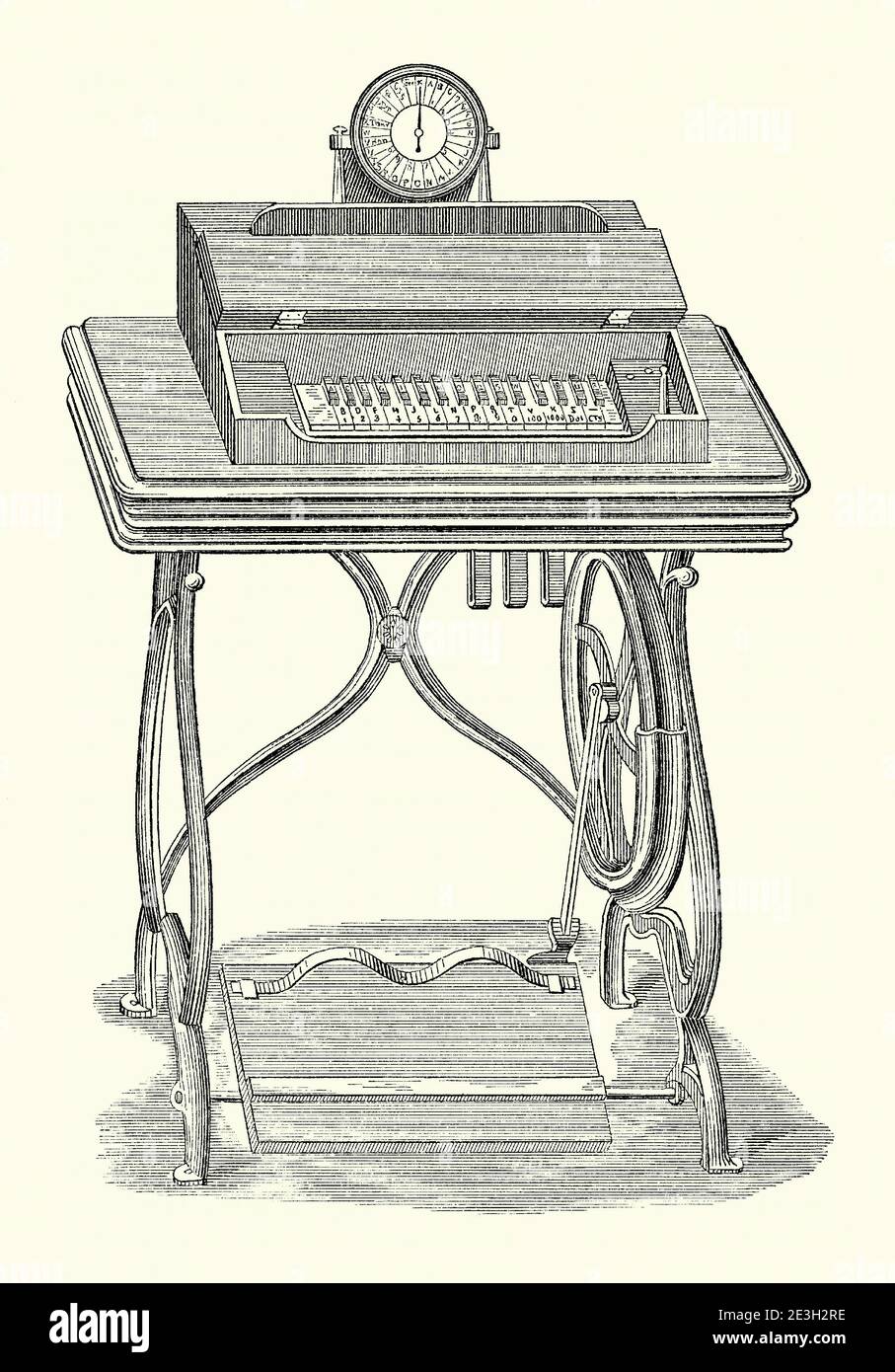 An old engraving of a printing telegraph stand designed by George L Anders. It is from a mechanical engineering book of the 1880s. The stand has a keyboard and visible dial or typewheel. The typewheel at the sending end was synchronised to a similar wheel at the receiving end. When the character key was pressed at the home station, it actuated the typewheel at the distant station just as the same character moved into the printing position – an example of a synchronous data transmission system. When transmitting power was provided to the electric magneto by the foot treadle. Stock Photohttps://www.alamy.com/image-license-details/?v=1https://www.alamy.com/an-old-engraving-of-a-printing-telegraph-stand-designed-by-george-l-anders-it-is-from-a-mechanical-engineering-book-of-the-1880s-the-stand-has-a-keyboard-and-visible-dial-or-typewheel-the-typewheel-at-the-sending-end-was-synchronised-to-a-similar-wheel-at-the-receiving-end-when-the-character-key-was-pressed-at-the-home-station-it-actuated-the-typewheel-at-the-distant-station-just-as-the-same-character-moved-into-the-printing-position-an-example-of-a-synchronous-data-transmission-system-when-transmitting-power-was-provided-to-the-electric-magneto-by-the-foot-treadle-image398057842.html
An old engraving of a printing telegraph stand designed by George L Anders. It is from a mechanical engineering book of the 1880s. The stand has a keyboard and visible dial or typewheel. The typewheel at the sending end was synchronised to a similar wheel at the receiving end. When the character key was pressed at the home station, it actuated the typewheel at the distant station just as the same character moved into the printing position – an example of a synchronous data transmission system. When transmitting power was provided to the electric magneto by the foot treadle. Stock Photohttps://www.alamy.com/image-license-details/?v=1https://www.alamy.com/an-old-engraving-of-a-printing-telegraph-stand-designed-by-george-l-anders-it-is-from-a-mechanical-engineering-book-of-the-1880s-the-stand-has-a-keyboard-and-visible-dial-or-typewheel-the-typewheel-at-the-sending-end-was-synchronised-to-a-similar-wheel-at-the-receiving-end-when-the-character-key-was-pressed-at-the-home-station-it-actuated-the-typewheel-at-the-distant-station-just-as-the-same-character-moved-into-the-printing-position-an-example-of-a-synchronous-data-transmission-system-when-transmitting-power-was-provided-to-the-electric-magneto-by-the-foot-treadle-image398057842.htmlRM2E3H2RE–An old engraving of a printing telegraph stand designed by George L Anders. It is from a mechanical engineering book of the 1880s. The stand has a keyboard and visible dial or typewheel. The typewheel at the sending end was synchronised to a similar wheel at the receiving end. When the character key was pressed at the home station, it actuated the typewheel at the distant station just as the same character moved into the printing position – an example of a synchronous data transmission system. When transmitting power was provided to the electric magneto by the foot treadle.
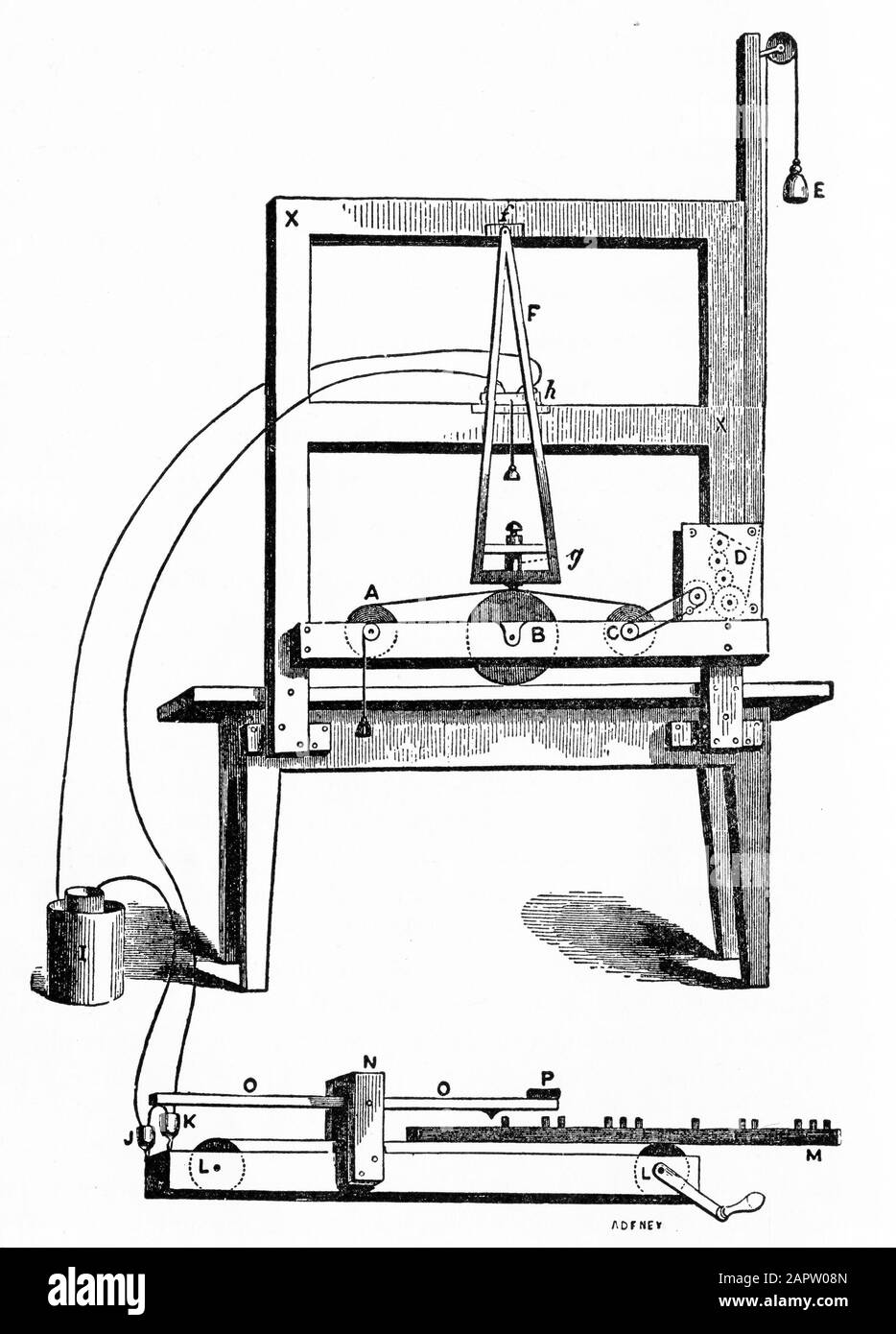 Engraving of the first Morse instrument and key Stock Photohttps://www.alamy.com/image-license-details/?v=1https://www.alamy.com/engraving-of-the-first-morse-instrument-and-key-image341068469.html
Engraving of the first Morse instrument and key Stock Photohttps://www.alamy.com/image-license-details/?v=1https://www.alamy.com/engraving-of-the-first-morse-instrument-and-key-image341068469.htmlRM2APW08N–Engraving of the first Morse instrument and key
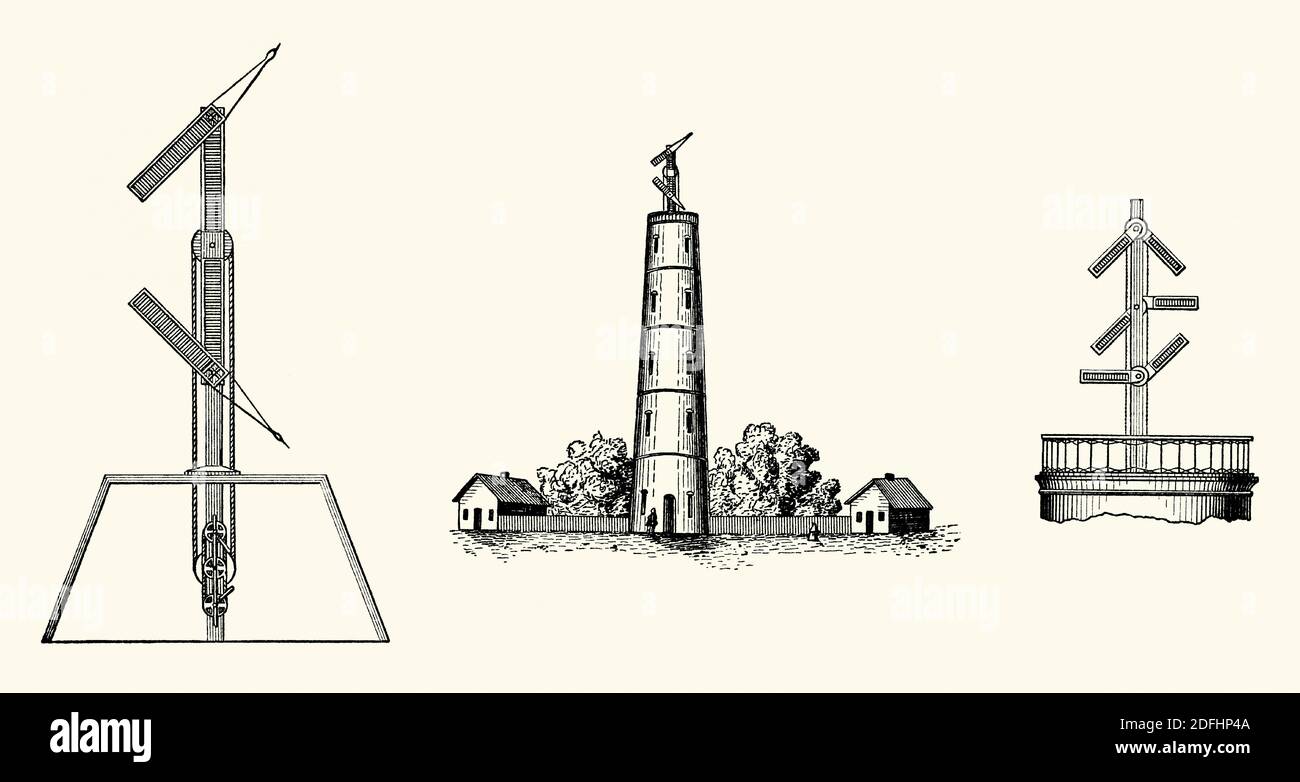 An old engraving of an optical telegraph (semaphore). It is from a Victorian book of the 1880s. It involved a line of stations (towers about 5–20 miles apart), passing visual signals or semaphores (centre pic). Station operators watched their nearest towers through a telescope. When the ‘arms’ spelt out letters/symbols, they would pass these to the next tower. The most used type was by Frenchman Claude Chappe (1792). Long arms with 7 positions, plus a connecting crossbar with 4 different angles (left), created 196 symbols. The Prussian system (right) had 6 wings and was capable of 4096 symbols Stock Photohttps://www.alamy.com/image-license-details/?v=1https://www.alamy.com/an-old-engraving-of-an-optical-telegraph-semaphore-it-is-from-a-victorian-book-of-the-1880s-it-involved-a-line-of-stations-towers-about-520-miles-apart-passing-visual-signals-or-semaphores-centre-pic-station-operators-watched-their-nearest-towers-through-a-telescope-when-the-arms-spelt-out-letterssymbols-they-would-pass-these-to-the-next-tower-the-most-used-type-was-by-frenchman-claude-chappe-1792-long-arms-with-7-positions-plus-a-connecting-crossbar-with-4-different-angles-left-created-196-symbols-the-prussian-system-right-had-6-wings-and-was-capable-of-4096-symbols-image388238490.html
An old engraving of an optical telegraph (semaphore). It is from a Victorian book of the 1880s. It involved a line of stations (towers about 5–20 miles apart), passing visual signals or semaphores (centre pic). Station operators watched their nearest towers through a telescope. When the ‘arms’ spelt out letters/symbols, they would pass these to the next tower. The most used type was by Frenchman Claude Chappe (1792). Long arms with 7 positions, plus a connecting crossbar with 4 different angles (left), created 196 symbols. The Prussian system (right) had 6 wings and was capable of 4096 symbols Stock Photohttps://www.alamy.com/image-license-details/?v=1https://www.alamy.com/an-old-engraving-of-an-optical-telegraph-semaphore-it-is-from-a-victorian-book-of-the-1880s-it-involved-a-line-of-stations-towers-about-520-miles-apart-passing-visual-signals-or-semaphores-centre-pic-station-operators-watched-their-nearest-towers-through-a-telescope-when-the-arms-spelt-out-letterssymbols-they-would-pass-these-to-the-next-tower-the-most-used-type-was-by-frenchman-claude-chappe-1792-long-arms-with-7-positions-plus-a-connecting-crossbar-with-4-different-angles-left-created-196-symbols-the-prussian-system-right-had-6-wings-and-was-capable-of-4096-symbols-image388238490.htmlRM2DFHP4A–An old engraving of an optical telegraph (semaphore). It is from a Victorian book of the 1880s. It involved a line of stations (towers about 5–20 miles apart), passing visual signals or semaphores (centre pic). Station operators watched their nearest towers through a telescope. When the ‘arms’ spelt out letters/symbols, they would pass these to the next tower. The most used type was by Frenchman Claude Chappe (1792). Long arms with 7 positions, plus a connecting crossbar with 4 different angles (left), created 196 symbols. The Prussian system (right) had 6 wings and was capable of 4096 symbols
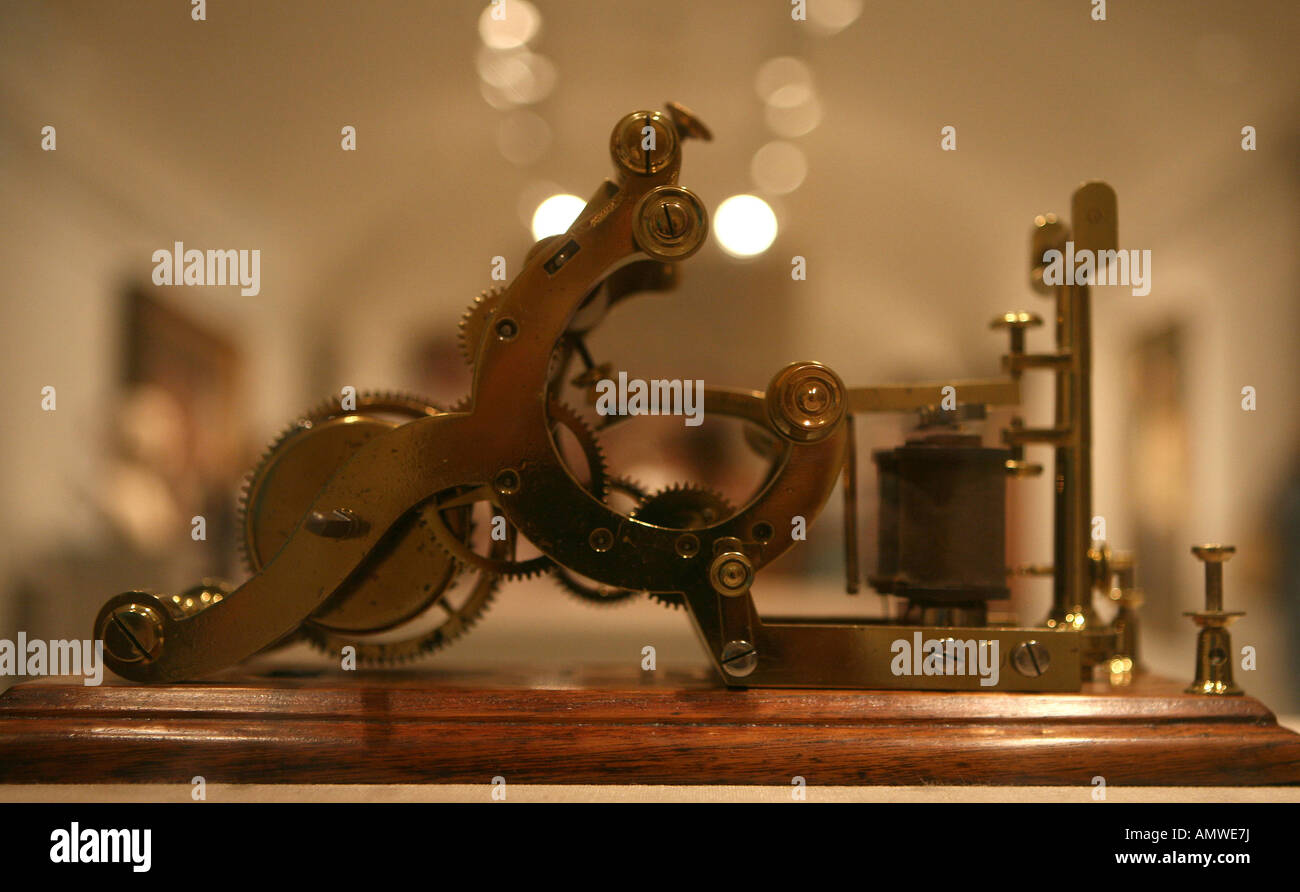 A patent model of the automatic telegraph receiver patented by Samurl F B Morse in 1837 Stock Photohttps://www.alamy.com/image-license-details/?v=1https://www.alamy.com/stock-photo-a-patent-model-of-the-automatic-telegraph-receiver-patented-by-samurl-15342965.html
A patent model of the automatic telegraph receiver patented by Samurl F B Morse in 1837 Stock Photohttps://www.alamy.com/image-license-details/?v=1https://www.alamy.com/stock-photo-a-patent-model-of-the-automatic-telegraph-receiver-patented-by-samurl-15342965.htmlRMAMWE7J–A patent model of the automatic telegraph receiver patented by Samurl F B Morse in 1837
 An old engraving of Grove’s battery cell of the mid-1800s. It is from a book of the 1890s on discoveries and inventions during the 1800s. The Grove cell was an early electric primary cell named after its inventor, Welsh scientist William Robert Grove (1811–1896), and consisted of a zinc anode in dilute sulphuric acid and a platinum cathode in concentrated nitric acid, the two separated by a porous ceramic pot (a single cell is shown left, the battery right). The Grove cell was the favoured power source of the early American telegraph system in the mid-1800s. Stock Photohttps://www.alamy.com/image-license-details/?v=1https://www.alamy.com/an-old-engraving-of-groves-battery-cell-of-the-mid-1800s-it-is-from-a-book-of-the-1890s-on-discoveries-and-inventions-during-the-1800s-the-grove-cell-was-an-early-electric-primary-cell-named-after-its-inventor-welsh-scientist-william-robert-grove-18111896-and-consisted-of-a-zinc-anode-in-dilute-sulphuric-acid-and-a-platinum-cathode-in-concentrated-nitric-acid-the-two-separated-by-a-porous-ceramic-pot-a-single-cell-is-shown-left-the-battery-right-the-grove-cell-was-the-favoured-power-source-of-the-early-american-telegraph-system-in-the-mid-1800s-image454530784.html
An old engraving of Grove’s battery cell of the mid-1800s. It is from a book of the 1890s on discoveries and inventions during the 1800s. The Grove cell was an early electric primary cell named after its inventor, Welsh scientist William Robert Grove (1811–1896), and consisted of a zinc anode in dilute sulphuric acid and a platinum cathode in concentrated nitric acid, the two separated by a porous ceramic pot (a single cell is shown left, the battery right). The Grove cell was the favoured power source of the early American telegraph system in the mid-1800s. Stock Photohttps://www.alamy.com/image-license-details/?v=1https://www.alamy.com/an-old-engraving-of-groves-battery-cell-of-the-mid-1800s-it-is-from-a-book-of-the-1890s-on-discoveries-and-inventions-during-the-1800s-the-grove-cell-was-an-early-electric-primary-cell-named-after-its-inventor-welsh-scientist-william-robert-grove-18111896-and-consisted-of-a-zinc-anode-in-dilute-sulphuric-acid-and-a-platinum-cathode-in-concentrated-nitric-acid-the-two-separated-by-a-porous-ceramic-pot-a-single-cell-is-shown-left-the-battery-right-the-grove-cell-was-the-favoured-power-source-of-the-early-american-telegraph-system-in-the-mid-1800s-image454530784.htmlRM2HBDJJ8–An old engraving of Grove’s battery cell of the mid-1800s. It is from a book of the 1890s on discoveries and inventions during the 1800s. The Grove cell was an early electric primary cell named after its inventor, Welsh scientist William Robert Grove (1811–1896), and consisted of a zinc anode in dilute sulphuric acid and a platinum cathode in concentrated nitric acid, the two separated by a porous ceramic pot (a single cell is shown left, the battery right). The Grove cell was the favoured power source of the early American telegraph system in the mid-1800s.
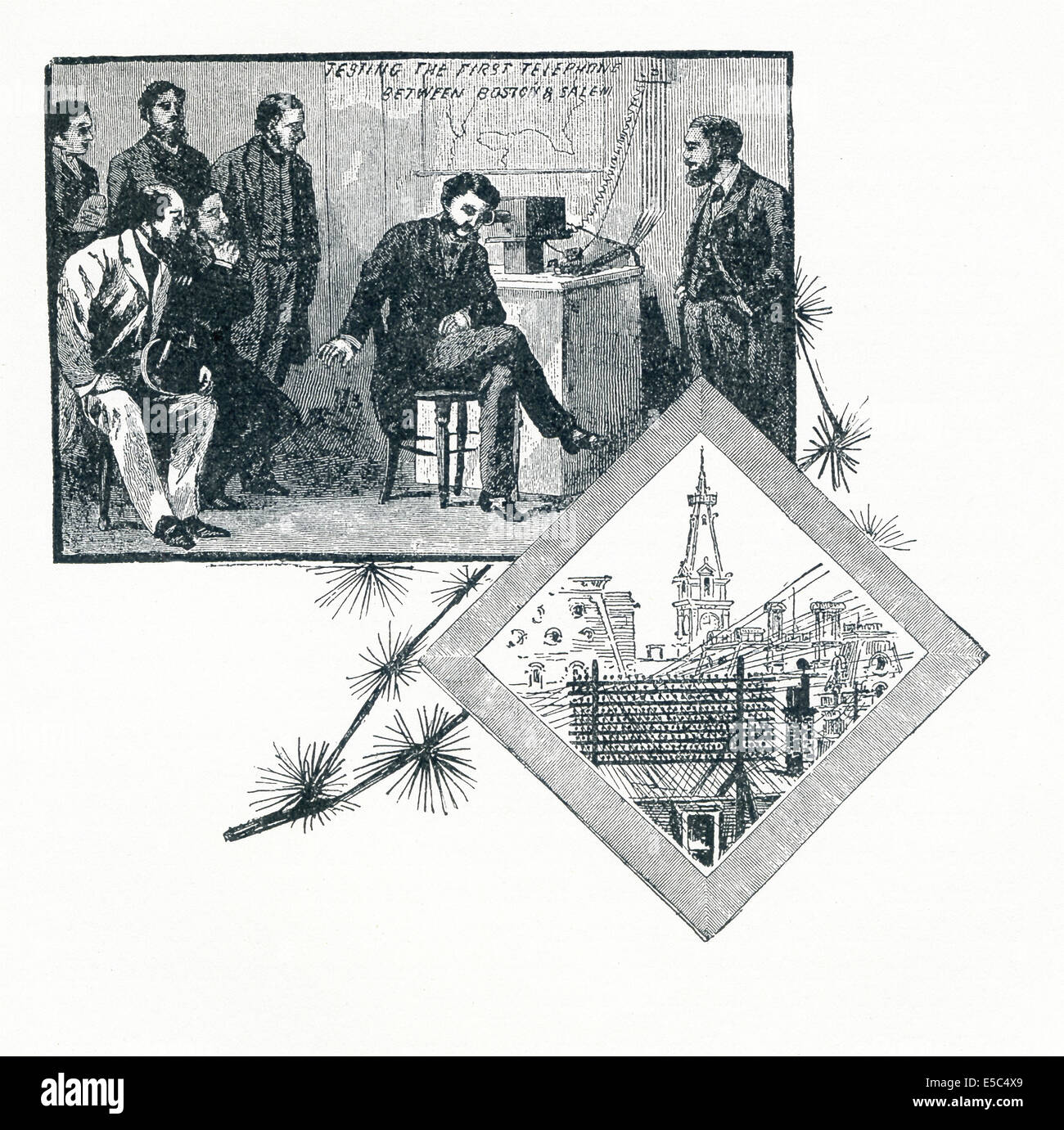 Alexander Graham Bell, in Salem, listens as the voice of his partner, Thomas Watson, comes through his machine from Boston. Stock Photohttps://www.alamy.com/image-license-details/?v=1https://www.alamy.com/stock-photo-alexander-graham-bell-in-salem-listens-as-the-voice-of-his-partner-72182049.html
Alexander Graham Bell, in Salem, listens as the voice of his partner, Thomas Watson, comes through his machine from Boston. Stock Photohttps://www.alamy.com/image-license-details/?v=1https://www.alamy.com/stock-photo-alexander-graham-bell-in-salem-listens-as-the-voice-of-his-partner-72182049.htmlRME5C4X9–Alexander Graham Bell, in Salem, listens as the voice of his partner, Thomas Watson, comes through his machine from Boston.
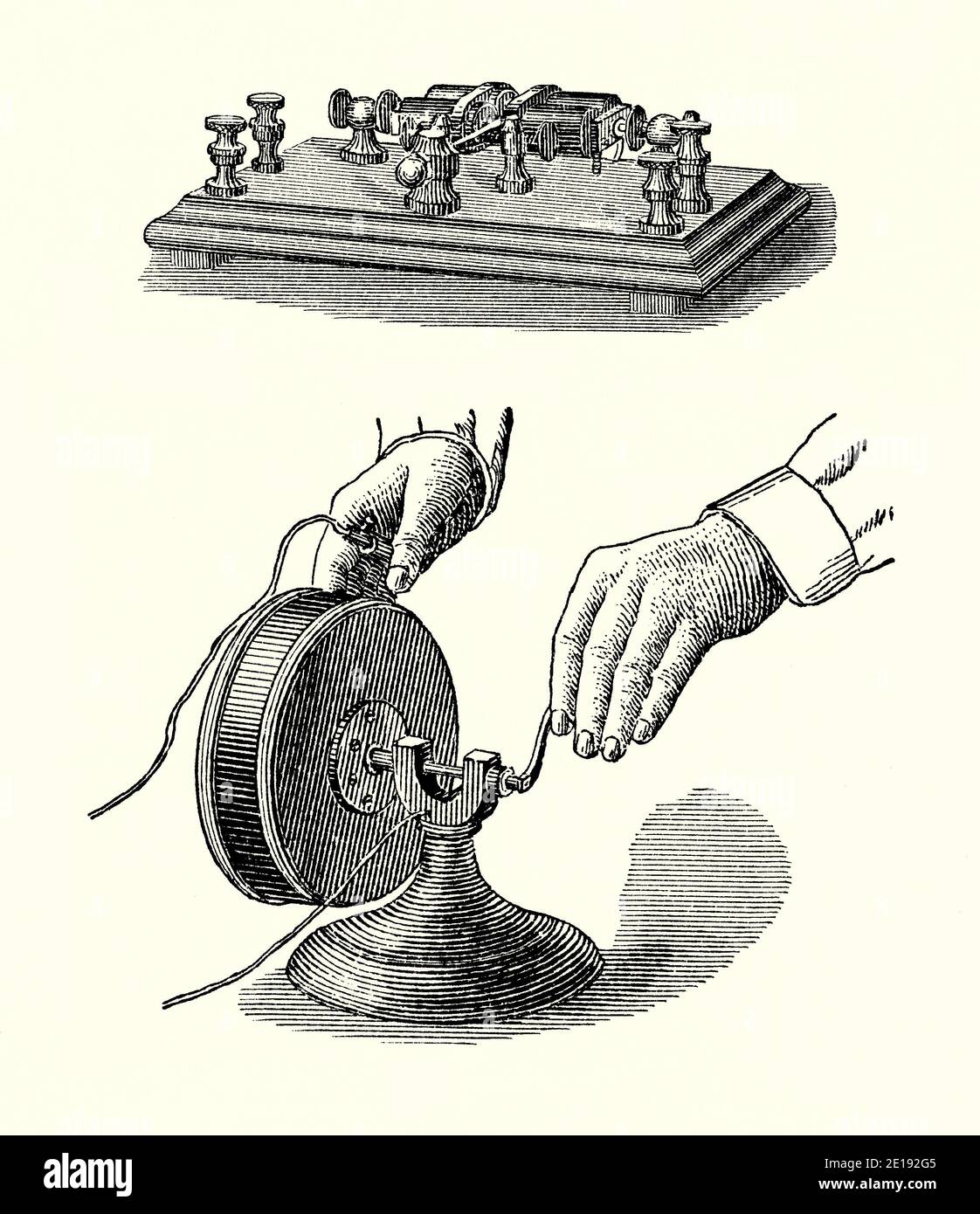 An old engraving of Gray’s telegraphic transmitter (top) and receiver (below). It is from a Victorian mechanical engineering book of the 1880s. Elisha Gray (1835 –1901) was an American electrical engineer who co-founded the Western Electric Manufacturing Company. Gray is best known for his development of a telephone prototype in 1876 in Highland Park, Illinois, USA. He also designed this composite tone device. The transmitter shows a single key connected to two electro-magnets. The receiver used a wooden soundbox covered in thin metal to reproduce sounds. Stock Photohttps://www.alamy.com/image-license-details/?v=1https://www.alamy.com/an-old-engraving-of-grays-telegraphic-transmitter-top-and-receiver-below-it-is-from-a-victorian-mechanical-engineering-book-of-the-1880s-elisha-gray-1835-1901-was-an-american-electrical-engineer-who-co-founded-the-western-electric-manufacturing-company-gray-is-best-known-for-his-development-of-a-telephone-prototype-in-1876-in-highland-park-illinois-usa-he-also-designed-this-composite-tone-device-the-transmitter-shows-a-single-key-connected-to-two-electro-magnets-the-receiver-used-a-wooden-soundbox-covered-in-thin-metal-to-reproduce-sounds-image396652709.html
An old engraving of Gray’s telegraphic transmitter (top) and receiver (below). It is from a Victorian mechanical engineering book of the 1880s. Elisha Gray (1835 –1901) was an American electrical engineer who co-founded the Western Electric Manufacturing Company. Gray is best known for his development of a telephone prototype in 1876 in Highland Park, Illinois, USA. He also designed this composite tone device. The transmitter shows a single key connected to two electro-magnets. The receiver used a wooden soundbox covered in thin metal to reproduce sounds. Stock Photohttps://www.alamy.com/image-license-details/?v=1https://www.alamy.com/an-old-engraving-of-grays-telegraphic-transmitter-top-and-receiver-below-it-is-from-a-victorian-mechanical-engineering-book-of-the-1880s-elisha-gray-1835-1901-was-an-american-electrical-engineer-who-co-founded-the-western-electric-manufacturing-company-gray-is-best-known-for-his-development-of-a-telephone-prototype-in-1876-in-highland-park-illinois-usa-he-also-designed-this-composite-tone-device-the-transmitter-shows-a-single-key-connected-to-two-electro-magnets-the-receiver-used-a-wooden-soundbox-covered-in-thin-metal-to-reproduce-sounds-image396652709.htmlRM2E192G5–An old engraving of Gray’s telegraphic transmitter (top) and receiver (below). It is from a Victorian mechanical engineering book of the 1880s. Elisha Gray (1835 –1901) was an American electrical engineer who co-founded the Western Electric Manufacturing Company. Gray is best known for his development of a telephone prototype in 1876 in Highland Park, Illinois, USA. He also designed this composite tone device. The transmitter shows a single key connected to two electro-magnets. The receiver used a wooden soundbox covered in thin metal to reproduce sounds.
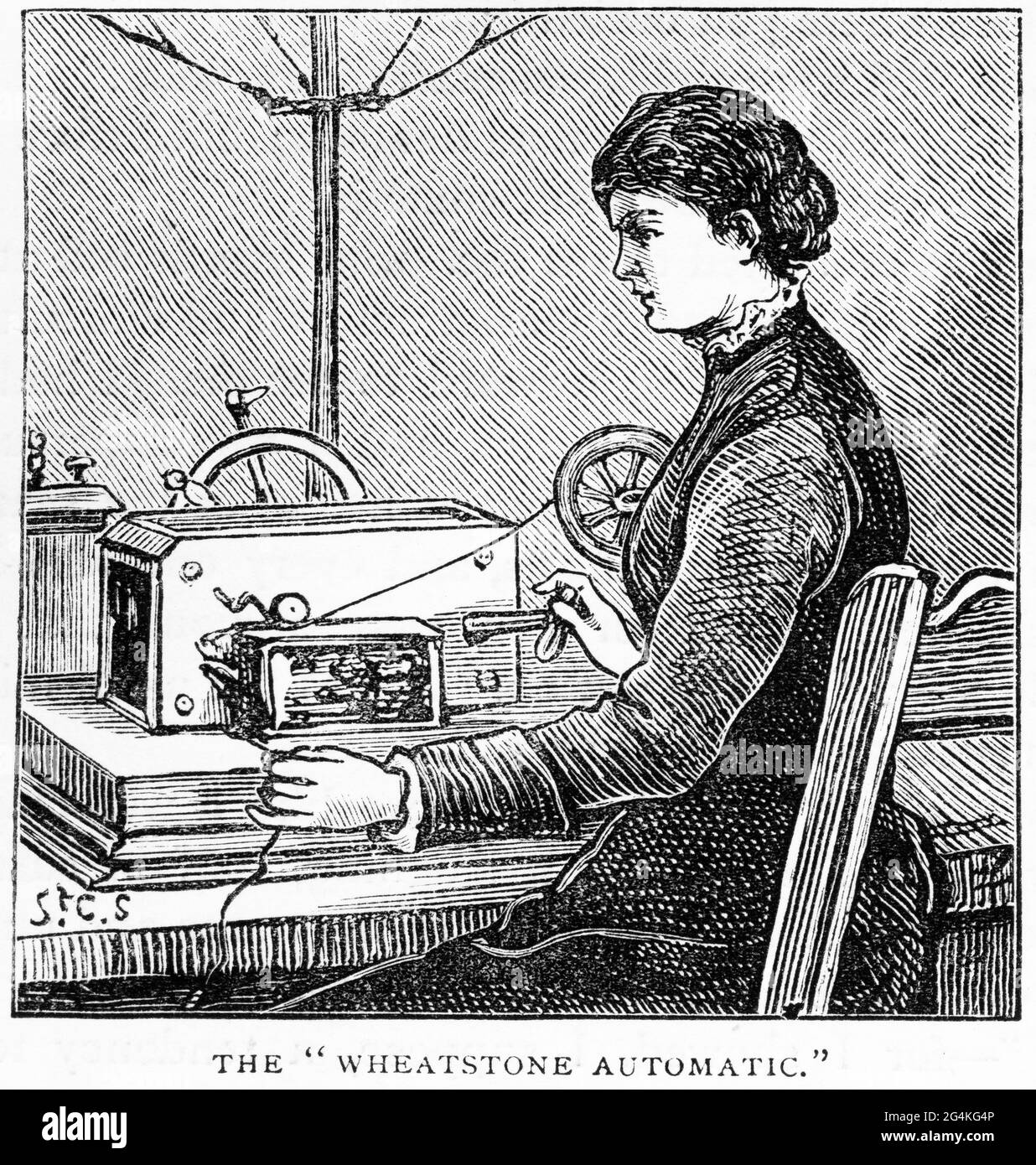 Engraving of a woman operating a Wheatstone Automatic telegraph machine capable of sending and receiving recorded morse code messages, circa 1890 Stock Photohttps://www.alamy.com/image-license-details/?v=1https://www.alamy.com/engraving-of-a-woman-operating-a-wheatstone-automatic-telegraph-machine-capable-of-sending-and-receiving-recorded-morse-code-messages-circa-1890-image433147590.html
Engraving of a woman operating a Wheatstone Automatic telegraph machine capable of sending and receiving recorded morse code messages, circa 1890 Stock Photohttps://www.alamy.com/image-license-details/?v=1https://www.alamy.com/engraving-of-a-woman-operating-a-wheatstone-automatic-telegraph-machine-capable-of-sending-and-receiving-recorded-morse-code-messages-circa-1890-image433147590.htmlRM2G4KG4P–Engraving of a woman operating a Wheatstone Automatic telegraph machine capable of sending and receiving recorded morse code messages, circa 1890
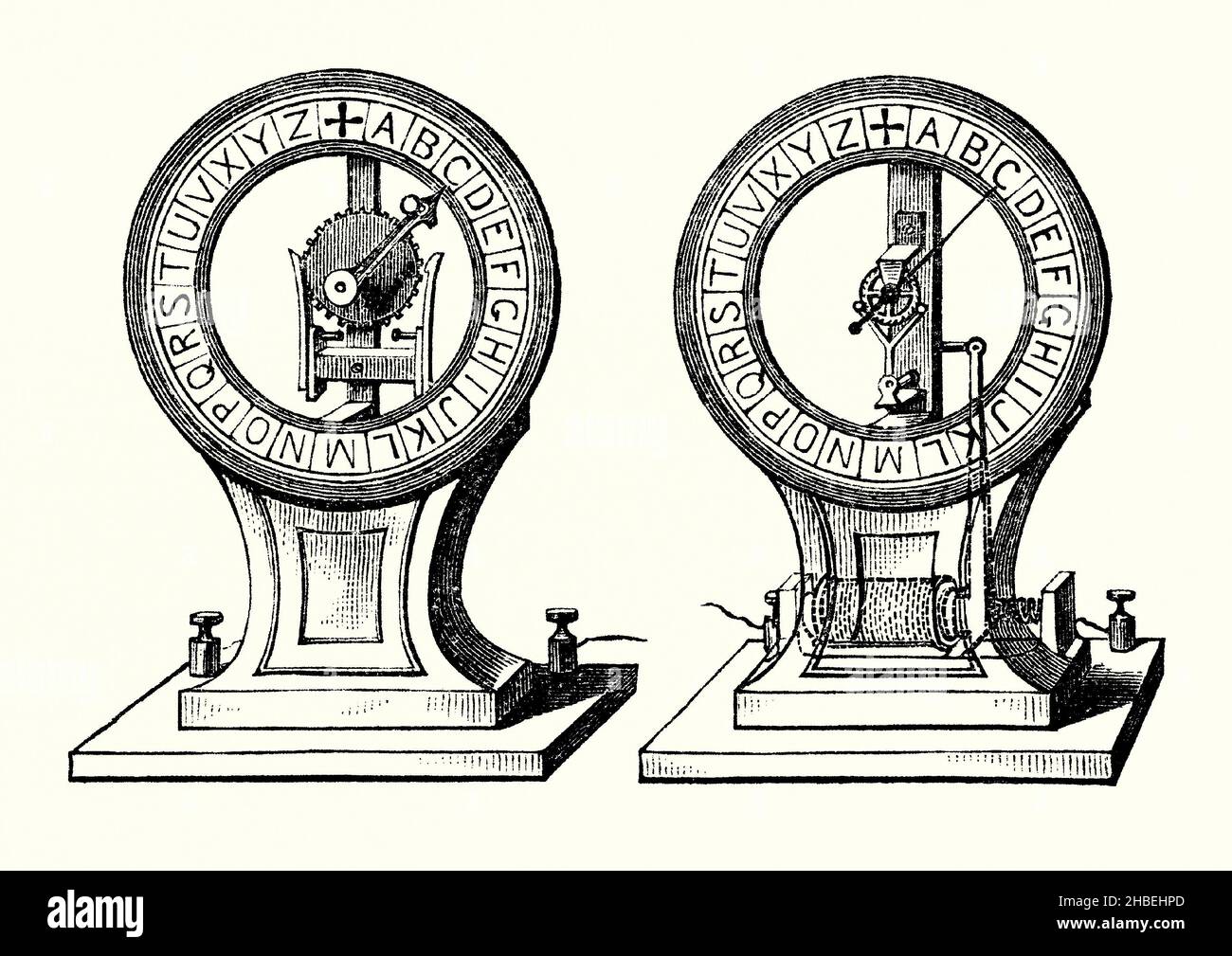 An old engraving of Gustave Froment’s alphabetical telegraph dials of 1850. It is from a book of the 1890s on discoveries and inventions during the 1800s. Paul Gustave Alexandre Froment (1815–1865) was a highly-skilled manufacturer of precision engineered apparatus. His Alphabetic Telegraph improved on Wheatstone's galvanic dial instrument. The instrument (on the left) is the sending device where an operator turns the clockwork hand to the desired letter, and subsequent words, to send – this is transmitted by battery power to the electro-magnetic receiver (right). Stock Photohttps://www.alamy.com/image-license-details/?v=1https://www.alamy.com/an-old-engraving-of-gustave-froments-alphabetical-telegraph-dials-of-1850-it-is-from-a-book-of-the-1890s-on-discoveries-and-inventions-during-the-1800s-paul-gustave-alexandre-froment-18151865-was-a-highly-skilled-manufacturer-of-precision-engineered-apparatus-his-alphabetic-telegraph-improved-on-wheatstones-galvanic-dial-instrument-the-instrument-on-the-left-is-the-sending-device-where-an-operator-turns-the-clockwork-hand-to-the-desired-letter-and-subsequent-words-to-send-this-is-transmitted-by-battery-power-to-the-electro-magnetic-receiver-right-image454552069.html
An old engraving of Gustave Froment’s alphabetical telegraph dials of 1850. It is from a book of the 1890s on discoveries and inventions during the 1800s. Paul Gustave Alexandre Froment (1815–1865) was a highly-skilled manufacturer of precision engineered apparatus. His Alphabetic Telegraph improved on Wheatstone's galvanic dial instrument. The instrument (on the left) is the sending device where an operator turns the clockwork hand to the desired letter, and subsequent words, to send – this is transmitted by battery power to the electro-magnetic receiver (right). Stock Photohttps://www.alamy.com/image-license-details/?v=1https://www.alamy.com/an-old-engraving-of-gustave-froments-alphabetical-telegraph-dials-of-1850-it-is-from-a-book-of-the-1890s-on-discoveries-and-inventions-during-the-1800s-paul-gustave-alexandre-froment-18151865-was-a-highly-skilled-manufacturer-of-precision-engineered-apparatus-his-alphabetic-telegraph-improved-on-wheatstones-galvanic-dial-instrument-the-instrument-on-the-left-is-the-sending-device-where-an-operator-turns-the-clockwork-hand-to-the-desired-letter-and-subsequent-words-to-send-this-is-transmitted-by-battery-power-to-the-electro-magnetic-receiver-right-image454552069.htmlRM2HBEHPD–An old engraving of Gustave Froment’s alphabetical telegraph dials of 1850. It is from a book of the 1890s on discoveries and inventions during the 1800s. Paul Gustave Alexandre Froment (1815–1865) was a highly-skilled manufacturer of precision engineered apparatus. His Alphabetic Telegraph improved on Wheatstone's galvanic dial instrument. The instrument (on the left) is the sending device where an operator turns the clockwork hand to the desired letter, and subsequent words, to send – this is transmitted by battery power to the electro-magnetic receiver (right).
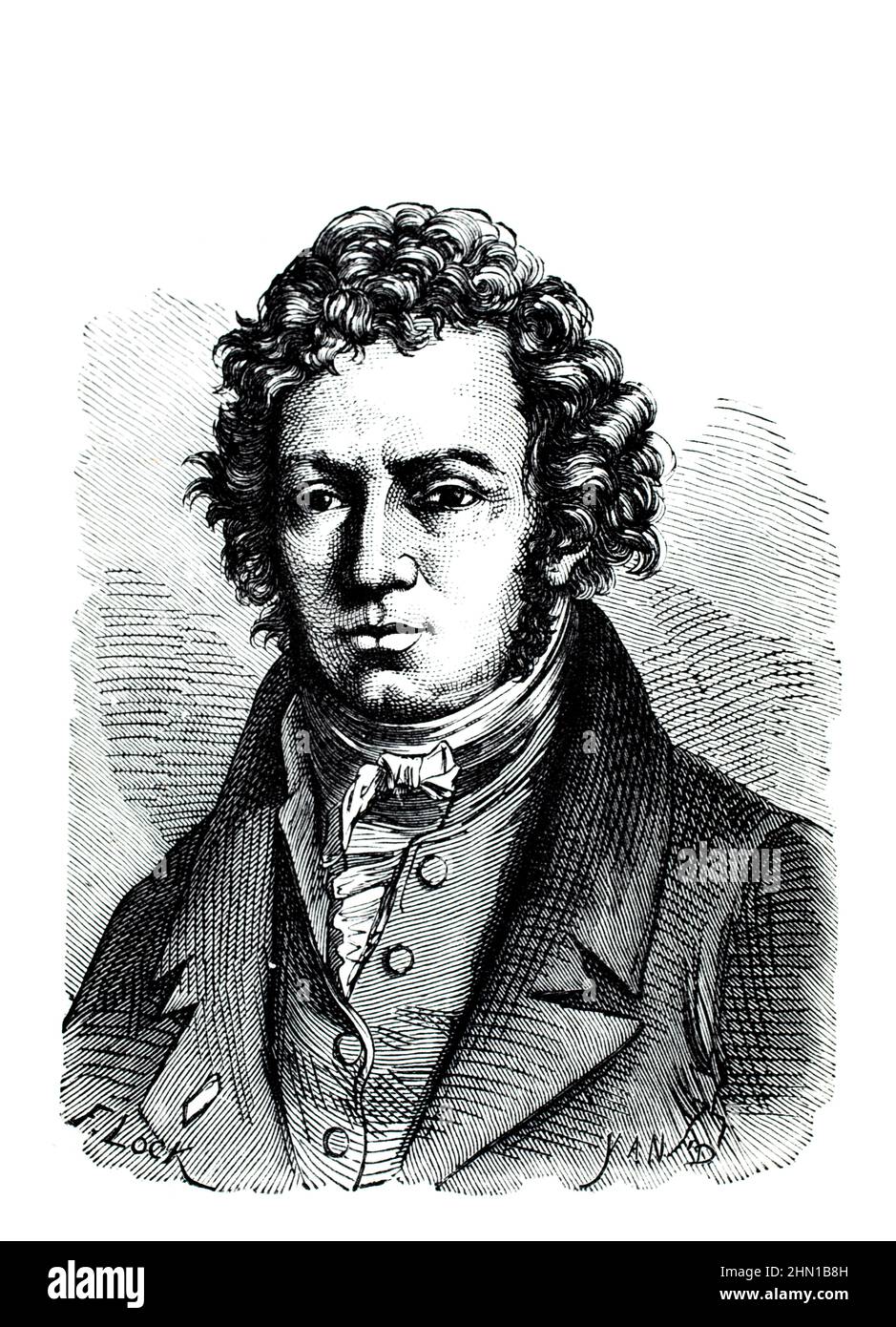 Science History, portrait of French physicist and mathematician André-Marie Ampère after whom the measurement of current is named Stock Photohttps://www.alamy.com/image-license-details/?v=1https://www.alamy.com/science-history-portrait-of-french-physicist-and-mathematician-andr-marie-ampre-after-whom-the-measurement-of-current-is-named-image460408161.html
Science History, portrait of French physicist and mathematician André-Marie Ampère after whom the measurement of current is named Stock Photohttps://www.alamy.com/image-license-details/?v=1https://www.alamy.com/science-history-portrait-of-french-physicist-and-mathematician-andr-marie-ampre-after-whom-the-measurement-of-current-is-named-image460408161.htmlRF2HN1B8H–Science History, portrait of French physicist and mathematician André-Marie Ampère after whom the measurement of current is named
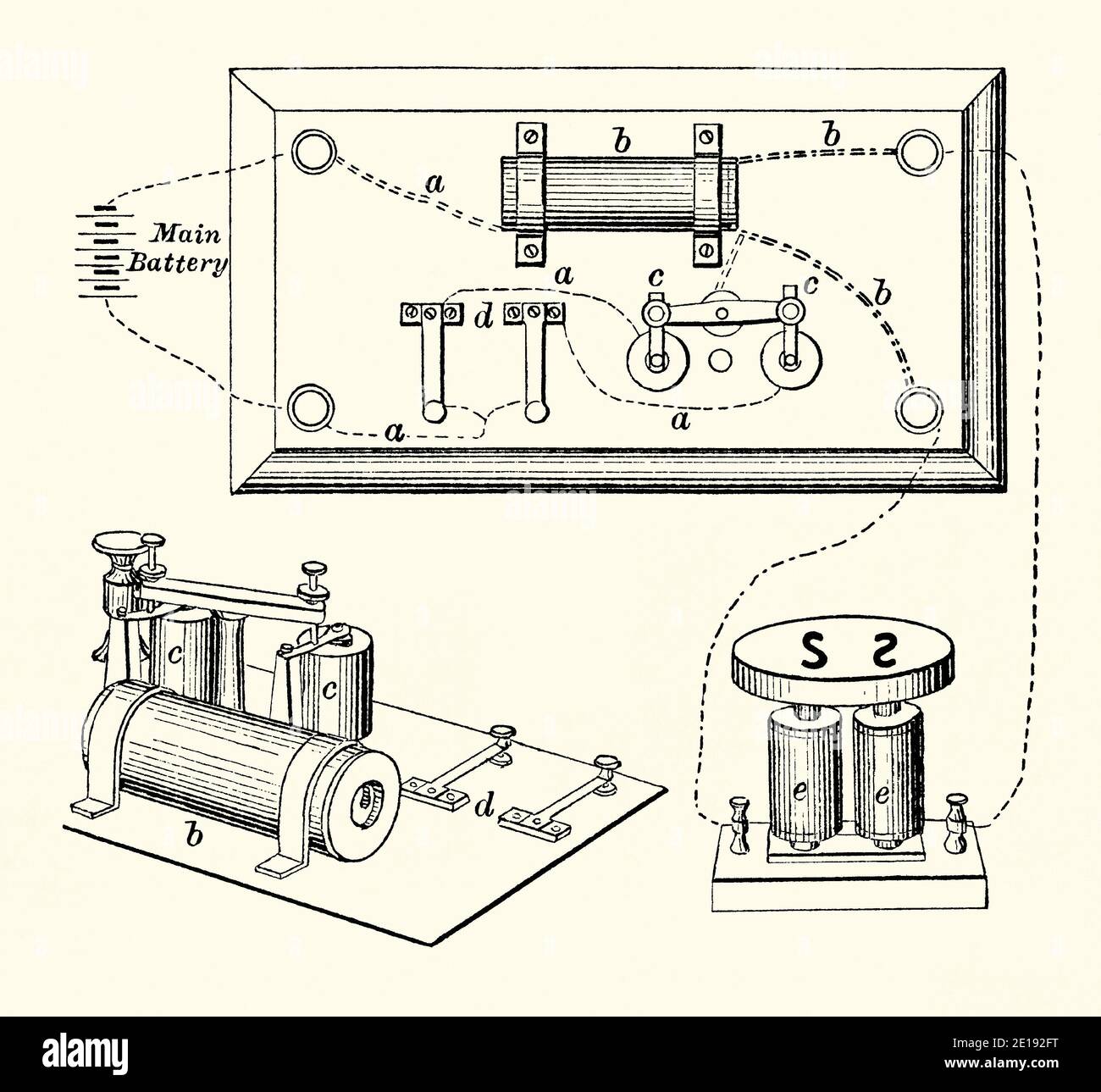 An old engraving of Gray’s ‘electro-harmonic telegraph’ of 1874. It is from a Victorian book of the 1880s. Elisha Gray (1835 –1901) was an American electrical engineer who co-founded the Western Electric Manufacturing Co. Gray is best known for his telephone prototype in 1876. His harmonic telegraph consisted of multi-tone transmitters, each tone with a telegraph key, transmitting musical tones. Oscillations were created by electromagnets and via a telegraph wire to a receiver (bott right) which reproduced the sound via a hollow metal cylinder on top of two magnets. Stock Photohttps://www.alamy.com/image-license-details/?v=1https://www.alamy.com/an-old-engraving-of-grays-electro-harmonic-telegraph-of-1874-it-is-from-a-victorian-book-of-the-1880s-elisha-gray-1835-1901-was-an-american-electrical-engineer-who-co-founded-the-western-electric-manufacturing-co-gray-is-best-known-for-his-telephone-prototype-in-1876-his-harmonic-telegraph-consisted-of-multi-tone-transmitters-each-tone-with-a-telegraph-key-transmitting-musical-tones-oscillations-were-created-by-electromagnets-and-via-a-telegraph-wire-to-a-receiver-bott-right-which-reproduced-the-sound-via-a-hollow-metal-cylinder-on-top-of-two-magnets-image396652700.html
An old engraving of Gray’s ‘electro-harmonic telegraph’ of 1874. It is from a Victorian book of the 1880s. Elisha Gray (1835 –1901) was an American electrical engineer who co-founded the Western Electric Manufacturing Co. Gray is best known for his telephone prototype in 1876. His harmonic telegraph consisted of multi-tone transmitters, each tone with a telegraph key, transmitting musical tones. Oscillations were created by electromagnets and via a telegraph wire to a receiver (bott right) which reproduced the sound via a hollow metal cylinder on top of two magnets. Stock Photohttps://www.alamy.com/image-license-details/?v=1https://www.alamy.com/an-old-engraving-of-grays-electro-harmonic-telegraph-of-1874-it-is-from-a-victorian-book-of-the-1880s-elisha-gray-1835-1901-was-an-american-electrical-engineer-who-co-founded-the-western-electric-manufacturing-co-gray-is-best-known-for-his-telephone-prototype-in-1876-his-harmonic-telegraph-consisted-of-multi-tone-transmitters-each-tone-with-a-telegraph-key-transmitting-musical-tones-oscillations-were-created-by-electromagnets-and-via-a-telegraph-wire-to-a-receiver-bott-right-which-reproduced-the-sound-via-a-hollow-metal-cylinder-on-top-of-two-magnets-image396652700.htmlRM2E192FT–An old engraving of Gray’s ‘electro-harmonic telegraph’ of 1874. It is from a Victorian book of the 1880s. Elisha Gray (1835 –1901) was an American electrical engineer who co-founded the Western Electric Manufacturing Co. Gray is best known for his telephone prototype in 1876. His harmonic telegraph consisted of multi-tone transmitters, each tone with a telegraph key, transmitting musical tones. Oscillations were created by electromagnets and via a telegraph wire to a receiver (bott right) which reproduced the sound via a hollow metal cylinder on top of two magnets.
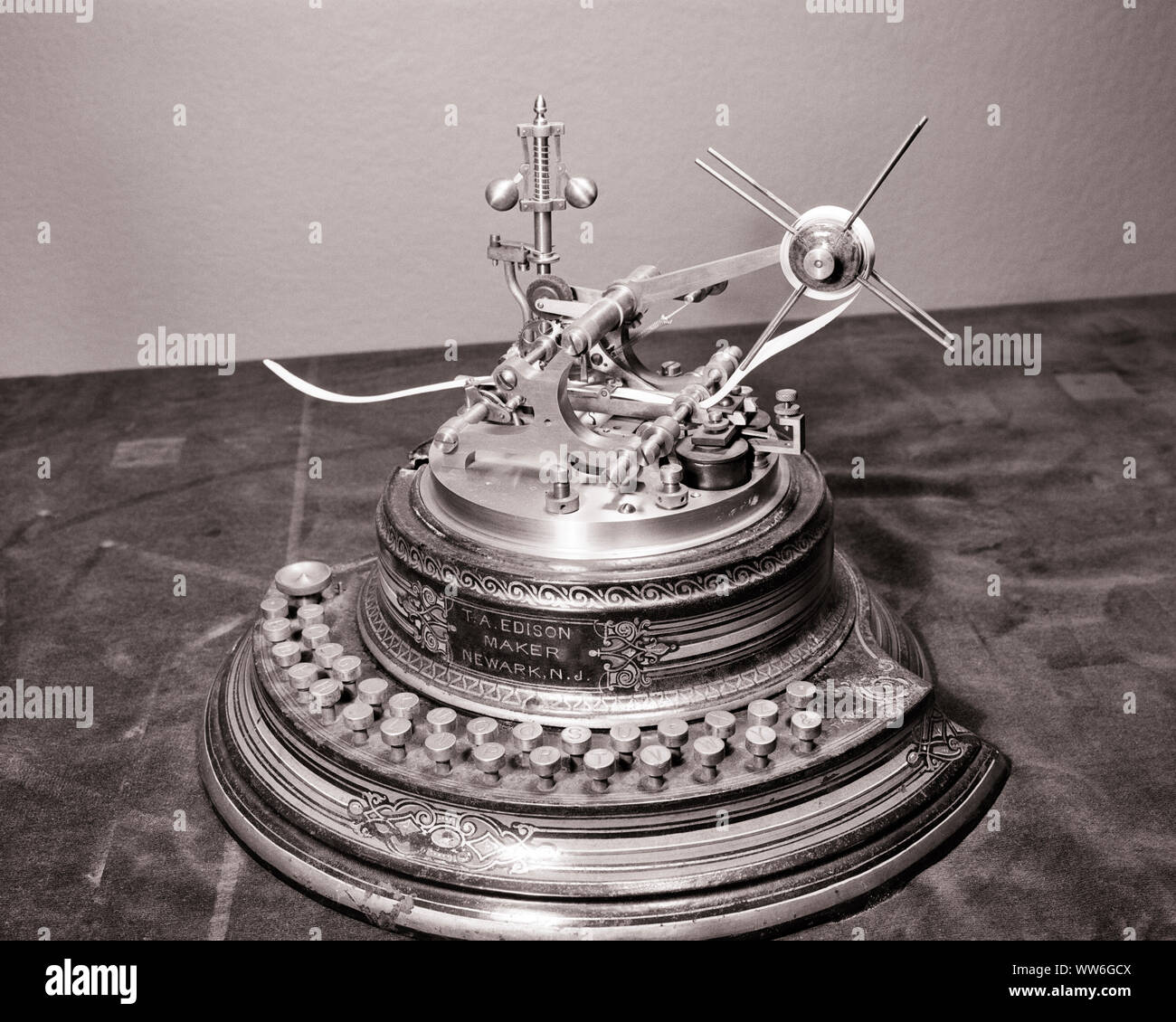 1800s 1870 EDISON'S FIRST STOCK TICKER INVENTED WHILE WORKING AT WESTERN UNION PATENT MONEY USED TO SET UP LAB MENLO PARK NJ USA - q50043 CPC001 HARS DISCOVERY PROGRESS INNOVATION UP NJ KENTUCKY THOMAS EDISON KY USED STILL LIFE STOCK TICKER IMAGINATION INVENTION NEW JERSEY ALVA HE LOUISVILLE MENLO CREATIVITY DEVICE INVENTOR SOLUTIONS TELEGRAPH 1870 BLACK AND WHITE INVENTED OLD FASHIONED WESTERN UNION Stock Photohttps://www.alamy.com/image-license-details/?v=1https://www.alamy.com/1800s-1870-edisons-first-stock-ticker-invented-while-working-at-western-union-patent-money-used-to-set-up-lab-menlo-park-nj-usa-q50043-cpc001-hars-discovery-progress-innovation-up-nj-kentucky-thomas-edison-ky-used-still-life-stock-ticker-imagination-invention-new-jersey-alva-he-louisville-menlo-creativity-device-inventor-solutions-telegraph-1870-black-and-white-invented-old-fashioned-western-union-image273666538.html
1800s 1870 EDISON'S FIRST STOCK TICKER INVENTED WHILE WORKING AT WESTERN UNION PATENT MONEY USED TO SET UP LAB MENLO PARK NJ USA - q50043 CPC001 HARS DISCOVERY PROGRESS INNOVATION UP NJ KENTUCKY THOMAS EDISON KY USED STILL LIFE STOCK TICKER IMAGINATION INVENTION NEW JERSEY ALVA HE LOUISVILLE MENLO CREATIVITY DEVICE INVENTOR SOLUTIONS TELEGRAPH 1870 BLACK AND WHITE INVENTED OLD FASHIONED WESTERN UNION Stock Photohttps://www.alamy.com/image-license-details/?v=1https://www.alamy.com/1800s-1870-edisons-first-stock-ticker-invented-while-working-at-western-union-patent-money-used-to-set-up-lab-menlo-park-nj-usa-q50043-cpc001-hars-discovery-progress-innovation-up-nj-kentucky-thomas-edison-ky-used-still-life-stock-ticker-imagination-invention-new-jersey-alva-he-louisville-menlo-creativity-device-inventor-solutions-telegraph-1870-black-and-white-invented-old-fashioned-western-union-image273666538.htmlRMWW6GCX–1800s 1870 EDISON'S FIRST STOCK TICKER INVENTED WHILE WORKING AT WESTERN UNION PATENT MONEY USED TO SET UP LAB MENLO PARK NJ USA - q50043 CPC001 HARS DISCOVERY PROGRESS INNOVATION UP NJ KENTUCKY THOMAS EDISON KY USED STILL LIFE STOCK TICKER IMAGINATION INVENTION NEW JERSEY ALVA HE LOUISVILLE MENLO CREATIVITY DEVICE INVENTOR SOLUTIONS TELEGRAPH 1870 BLACK AND WHITE INVENTED OLD FASHIONED WESTERN UNION
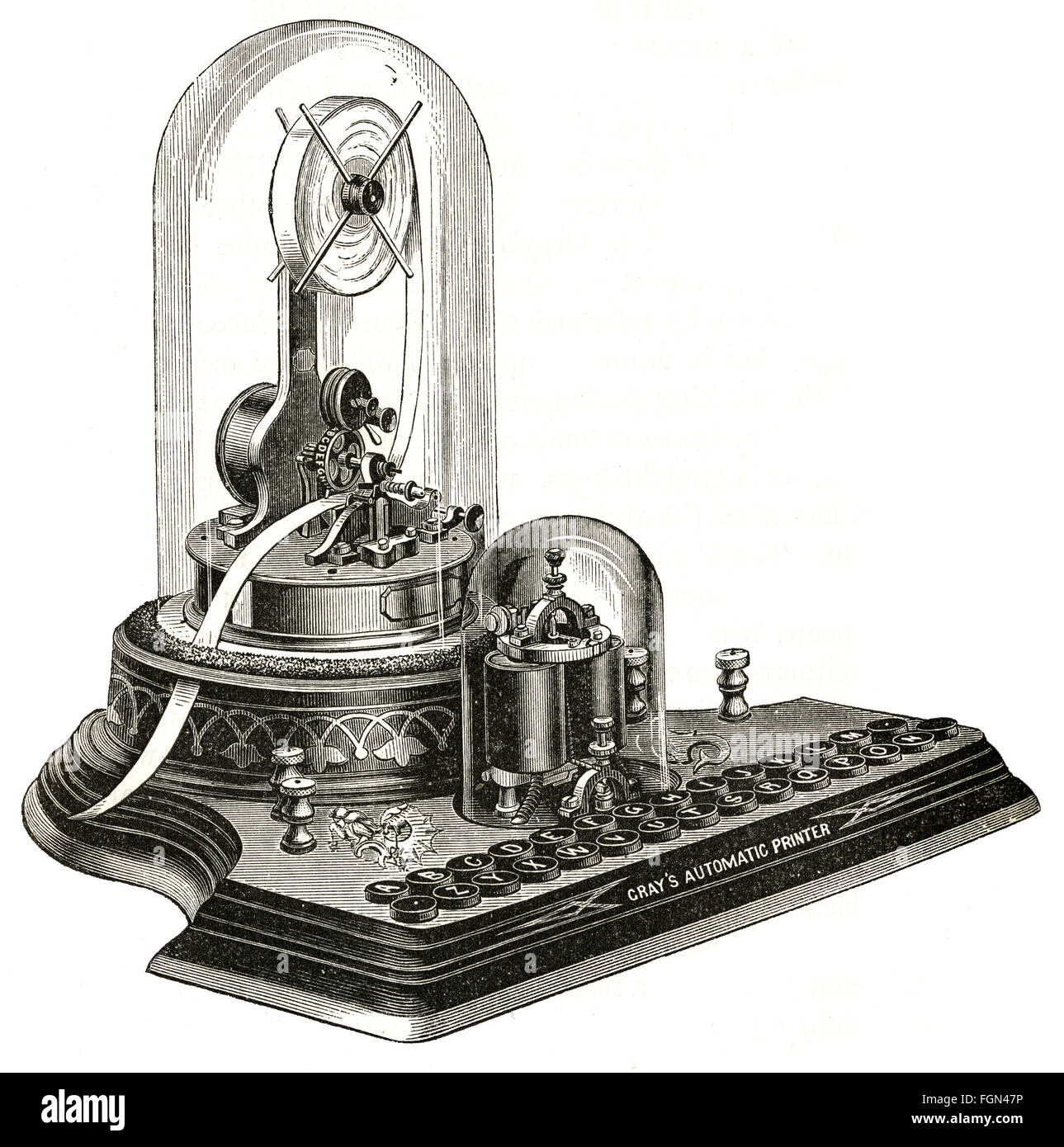 Antique 1877 engraving, Elisha Gray's Printing Telegraph for Private Lines. Stock Photohttps://www.alamy.com/image-license-details/?v=1https://www.alamy.com/stock-photo-antique-1877-engraving-elisha-grays-printing-telegraph-for-private-96350682.html
Antique 1877 engraving, Elisha Gray's Printing Telegraph for Private Lines. Stock Photohttps://www.alamy.com/image-license-details/?v=1https://www.alamy.com/stock-photo-antique-1877-engraving-elisha-grays-printing-telegraph-for-private-96350682.htmlRMFGN47P–Antique 1877 engraving, Elisha Gray's Printing Telegraph for Private Lines.
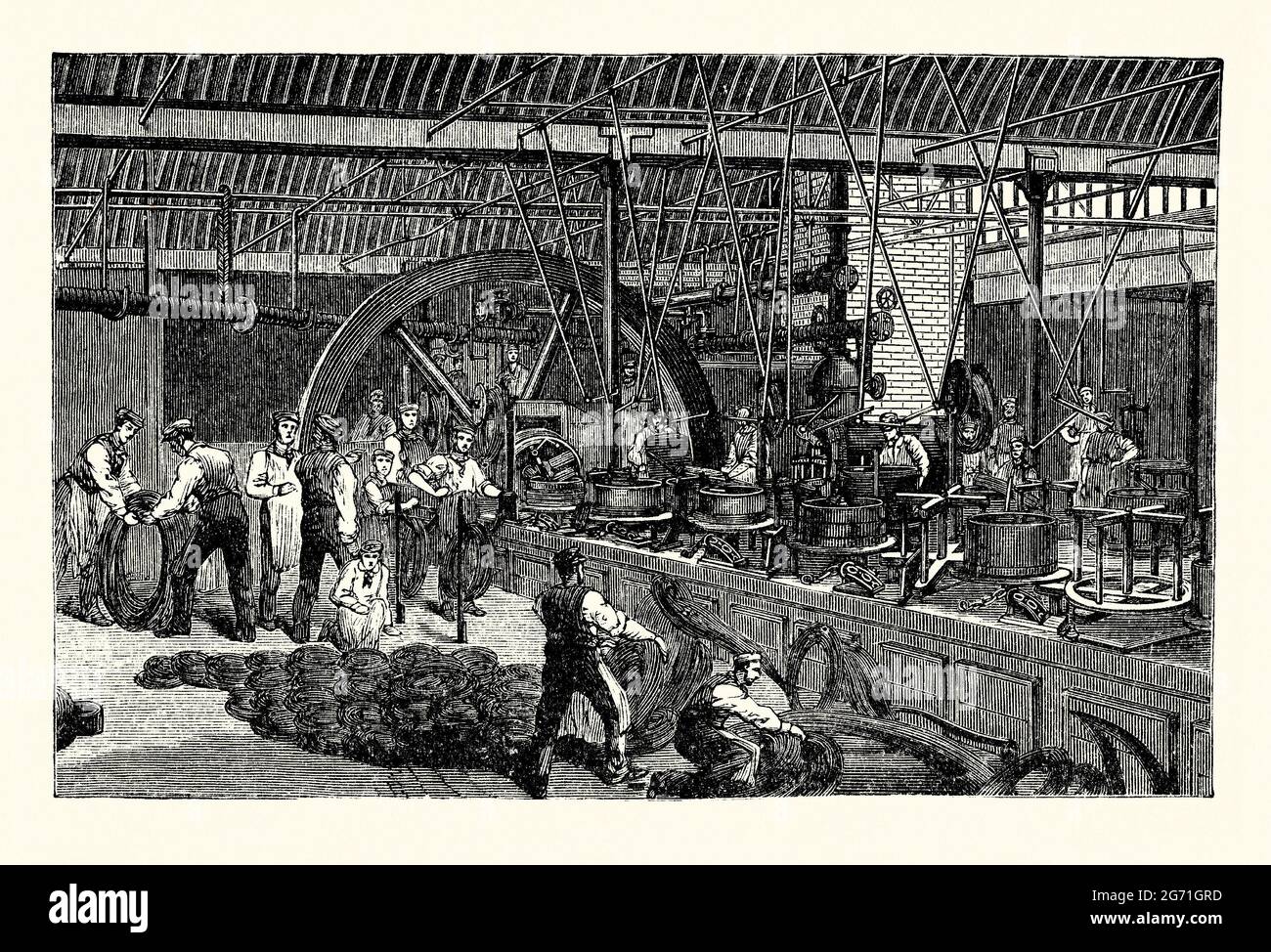 An old engraving of the outer, iron wire covering of the transatlantic telegraph cables being made at the factory of Webster & Horsfall, Birmingham, England, UK c.1865. It is from a book of the 1890s on Victorian discoveries and inventions during the 1800s. The cables themselves were manufactured by Glass, Elliot and Company in Greenwich, London. The cables were laid under the Atlantic Ocean for telegraph communications. This second cable was laid in 1865 from Brunel’s ship SS Great Eastern. The cable broke in mid-Atlantic; after many rescue attempts, it was abandoned. Stock Photohttps://www.alamy.com/image-license-details/?v=1https://www.alamy.com/an-old-engraving-of-the-outer-iron-wire-covering-of-the-transatlantic-telegraph-cables-being-made-at-the-factory-of-webster-horsfall-birmingham-england-uk-c1865-it-is-from-a-book-of-the-1890s-on-victorian-discoveries-and-inventions-during-the-1800s-the-cables-themselves-were-manufactured-by-glass-elliot-and-company-in-greenwich-london-the-cables-were-laid-under-the-atlantic-ocean-for-telegraph-communications-this-second-cable-was-laid-in-1865-from-brunels-ship-ss-great-eastern-the-cable-broke-in-mid-atlantic-after-many-rescue-attempts-it-was-abandoned-image434596945.html
An old engraving of the outer, iron wire covering of the transatlantic telegraph cables being made at the factory of Webster & Horsfall, Birmingham, England, UK c.1865. It is from a book of the 1890s on Victorian discoveries and inventions during the 1800s. The cables themselves were manufactured by Glass, Elliot and Company in Greenwich, London. The cables were laid under the Atlantic Ocean for telegraph communications. This second cable was laid in 1865 from Brunel’s ship SS Great Eastern. The cable broke in mid-Atlantic; after many rescue attempts, it was abandoned. Stock Photohttps://www.alamy.com/image-license-details/?v=1https://www.alamy.com/an-old-engraving-of-the-outer-iron-wire-covering-of-the-transatlantic-telegraph-cables-being-made-at-the-factory-of-webster-horsfall-birmingham-england-uk-c1865-it-is-from-a-book-of-the-1890s-on-victorian-discoveries-and-inventions-during-the-1800s-the-cables-themselves-were-manufactured-by-glass-elliot-and-company-in-greenwich-london-the-cables-were-laid-under-the-atlantic-ocean-for-telegraph-communications-this-second-cable-was-laid-in-1865-from-brunels-ship-ss-great-eastern-the-cable-broke-in-mid-atlantic-after-many-rescue-attempts-it-was-abandoned-image434596945.htmlRM2G71GRD–An old engraving of the outer, iron wire covering of the transatlantic telegraph cables being made at the factory of Webster & Horsfall, Birmingham, England, UK c.1865. It is from a book of the 1890s on Victorian discoveries and inventions during the 1800s. The cables themselves were manufactured by Glass, Elliot and Company in Greenwich, London. The cables were laid under the Atlantic Ocean for telegraph communications. This second cable was laid in 1865 from Brunel’s ship SS Great Eastern. The cable broke in mid-Atlantic; after many rescue attempts, it was abandoned.
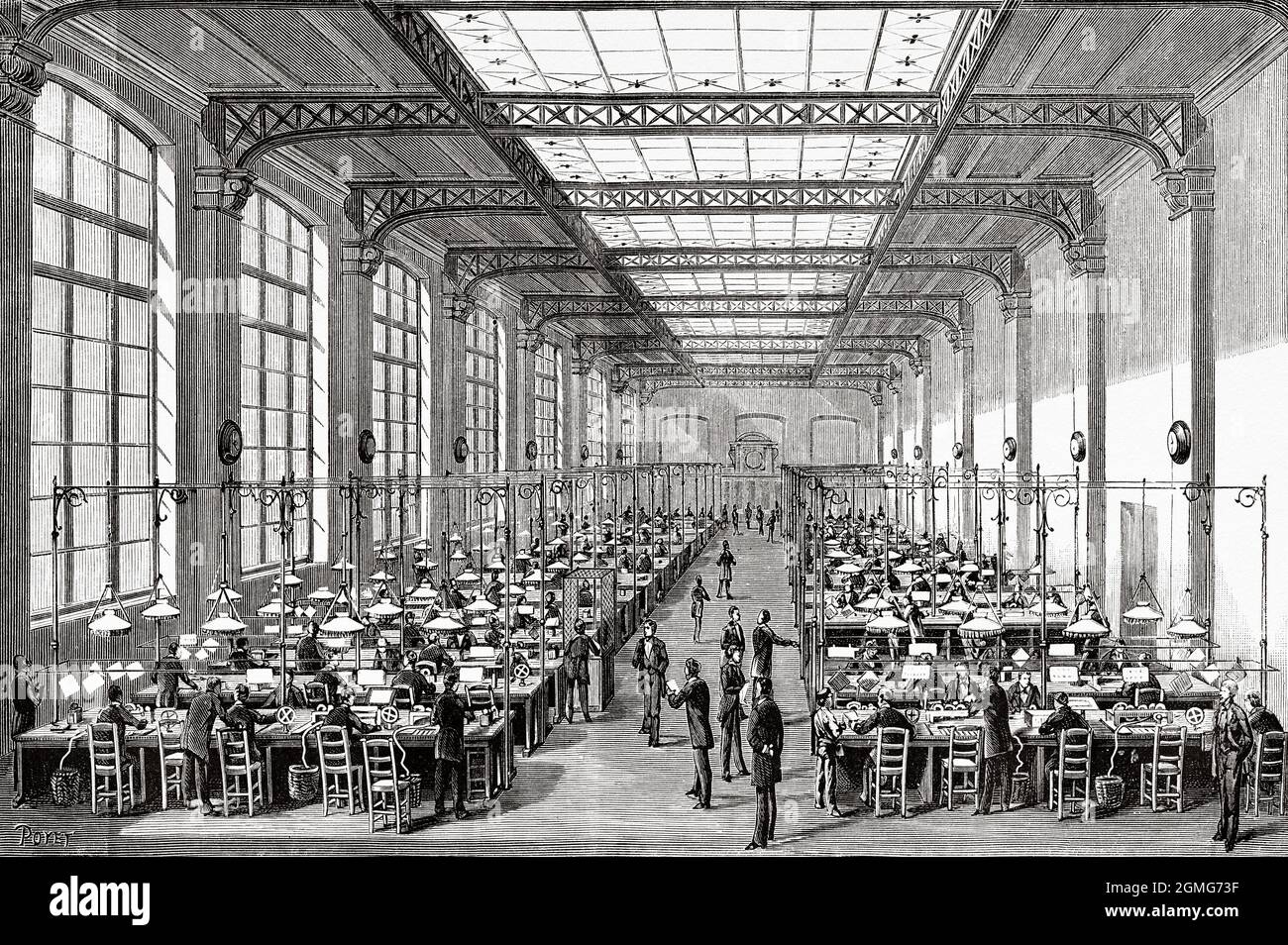 New central telegraph station in Paris 1884, France. Europe. Old 19th century engraved illustration from La Nature 1883 Stock Photohttps://www.alamy.com/image-license-details/?v=1https://www.alamy.com/new-central-telegraph-station-in-paris-1884-france-europe-old-19th-century-engraved-illustration-from-la-nature-1883-image442909139.html
New central telegraph station in Paris 1884, France. Europe. Old 19th century engraved illustration from La Nature 1883 Stock Photohttps://www.alamy.com/image-license-details/?v=1https://www.alamy.com/new-central-telegraph-station-in-paris-1884-france-europe-old-19th-century-engraved-illustration-from-la-nature-1883-image442909139.htmlRM2GMG73F–New central telegraph station in Paris 1884, France. Europe. Old 19th century engraved illustration from La Nature 1883
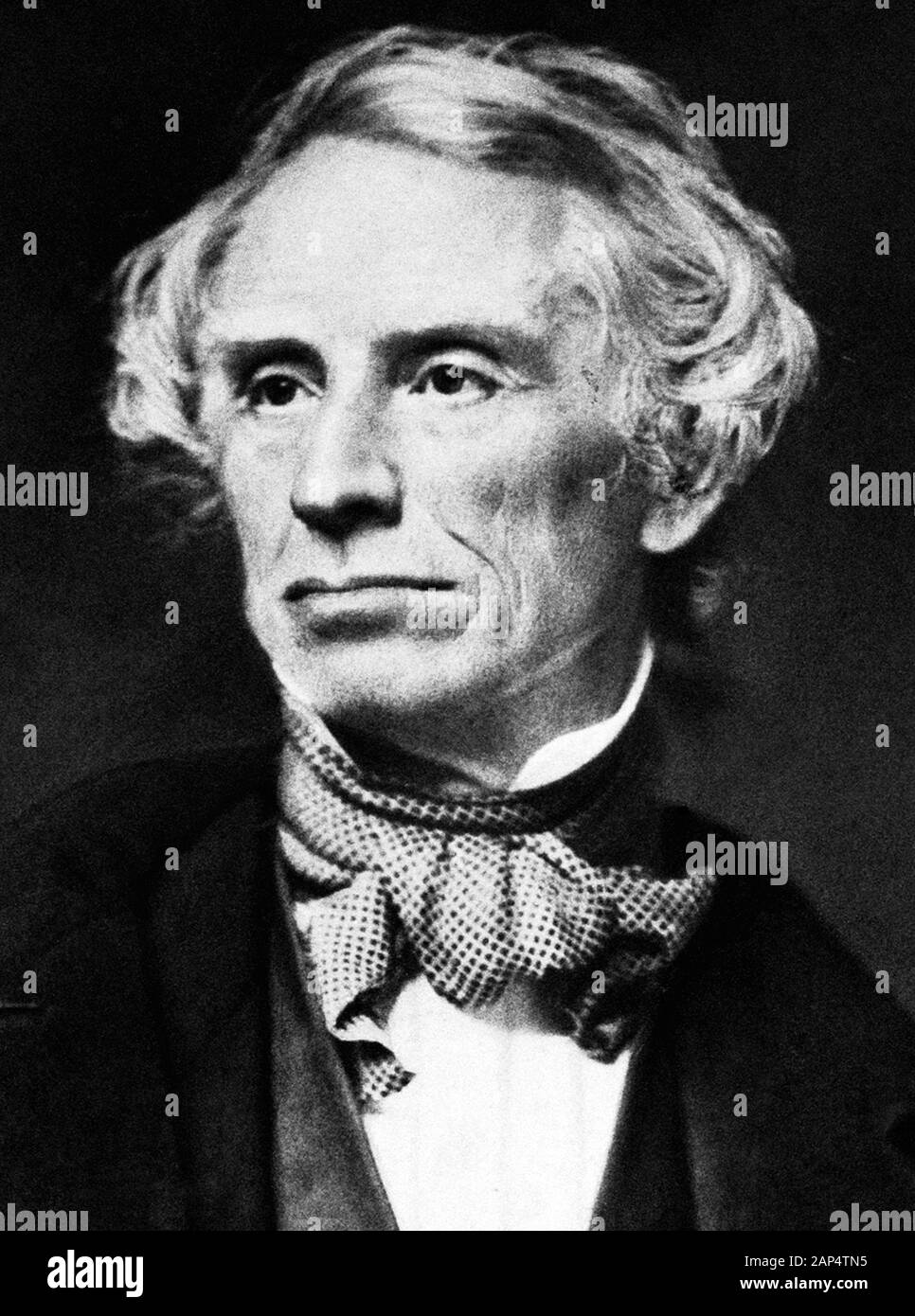 Vintage portrait photo of American painter and inventor Samuel F B Morse (1791 – 1872) – a pioneer in the development of the electric telegraph and co-creator of Morse Code. Photo circa 1855 by Mathew B Brady. Stock Photohttps://www.alamy.com/image-license-details/?v=1https://www.alamy.com/vintage-portrait-photo-of-american-painter-and-inventor-samuel-f-b-morse-1791-1872-a-pioneer-in-the-development-of-the-electric-telegraph-and-co-creator-of-morse-code-photo-circa-1855-by-mathew-b-brady-image340626641.html
Vintage portrait photo of American painter and inventor Samuel F B Morse (1791 – 1872) – a pioneer in the development of the electric telegraph and co-creator of Morse Code. Photo circa 1855 by Mathew B Brady. Stock Photohttps://www.alamy.com/image-license-details/?v=1https://www.alamy.com/vintage-portrait-photo-of-american-painter-and-inventor-samuel-f-b-morse-1791-1872-a-pioneer-in-the-development-of-the-electric-telegraph-and-co-creator-of-morse-code-photo-circa-1855-by-mathew-b-brady-image340626641.htmlRM2AP4TN5–Vintage portrait photo of American painter and inventor Samuel F B Morse (1791 – 1872) – a pioneer in the development of the electric telegraph and co-creator of Morse Code. Photo circa 1855 by Mathew B Brady.
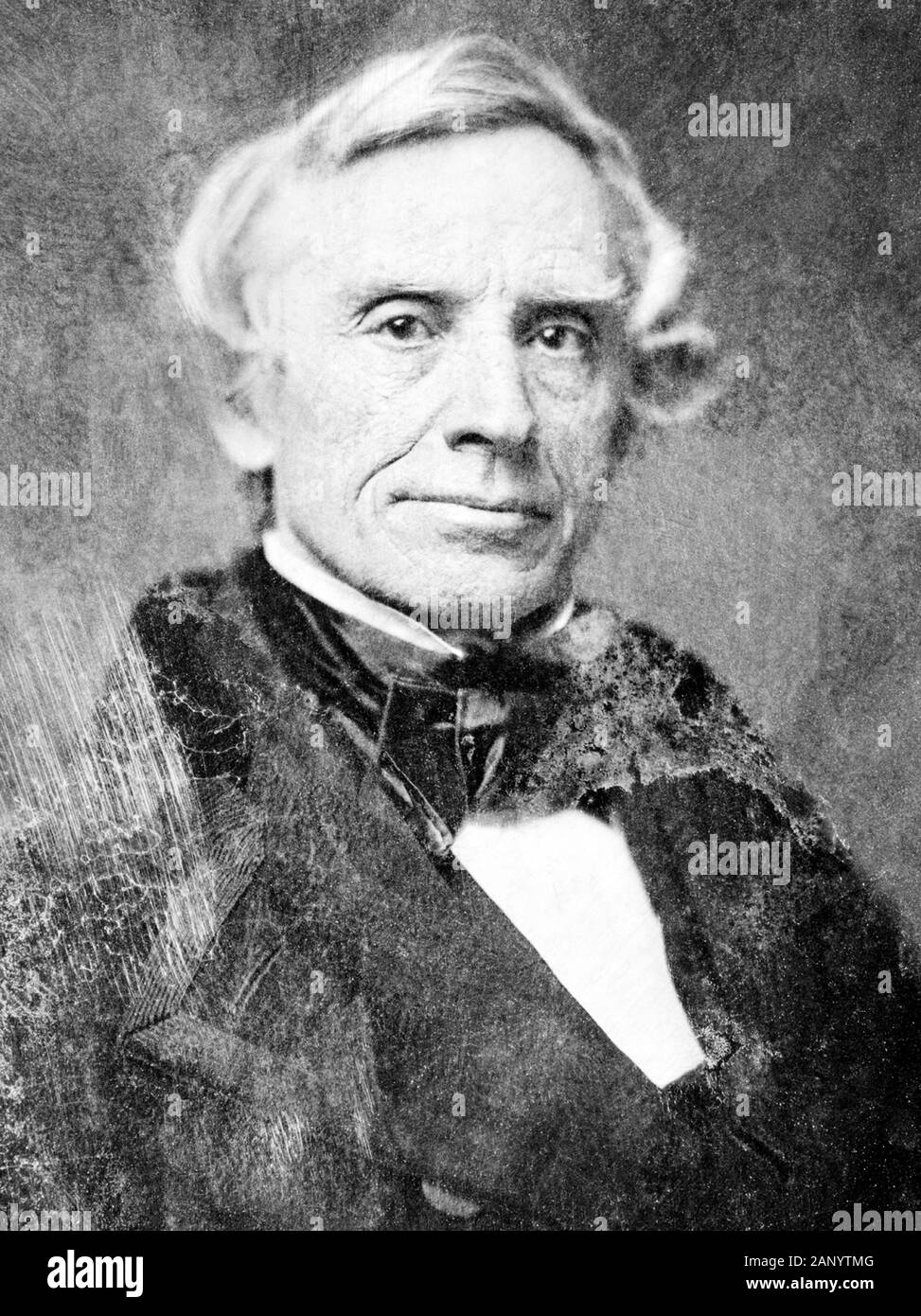 Vintage portrait photo of American painter and inventor Samuel F B Morse (1791 – 1872) – a pioneer in the development of the electric telegraph and co-creator of Morse Code. Photo circa 1850 by Mathew B Brady. Stock Photohttps://www.alamy.com/image-license-details/?v=1https://www.alamy.com/vintage-portrait-photo-of-american-painter-and-inventor-samuel-f-b-morse-1791-1872-a-pioneer-in-the-development-of-the-electric-telegraph-and-co-creator-of-morse-code-photo-circa-1850-by-mathew-b-brady-image340516864.html
Vintage portrait photo of American painter and inventor Samuel F B Morse (1791 – 1872) – a pioneer in the development of the electric telegraph and co-creator of Morse Code. Photo circa 1850 by Mathew B Brady. Stock Photohttps://www.alamy.com/image-license-details/?v=1https://www.alamy.com/vintage-portrait-photo-of-american-painter-and-inventor-samuel-f-b-morse-1791-1872-a-pioneer-in-the-development-of-the-electric-telegraph-and-co-creator-of-morse-code-photo-circa-1850-by-mathew-b-brady-image340516864.htmlRM2ANYTMG–Vintage portrait photo of American painter and inventor Samuel F B Morse (1791 – 1872) – a pioneer in the development of the electric telegraph and co-creator of Morse Code. Photo circa 1850 by Mathew B Brady.
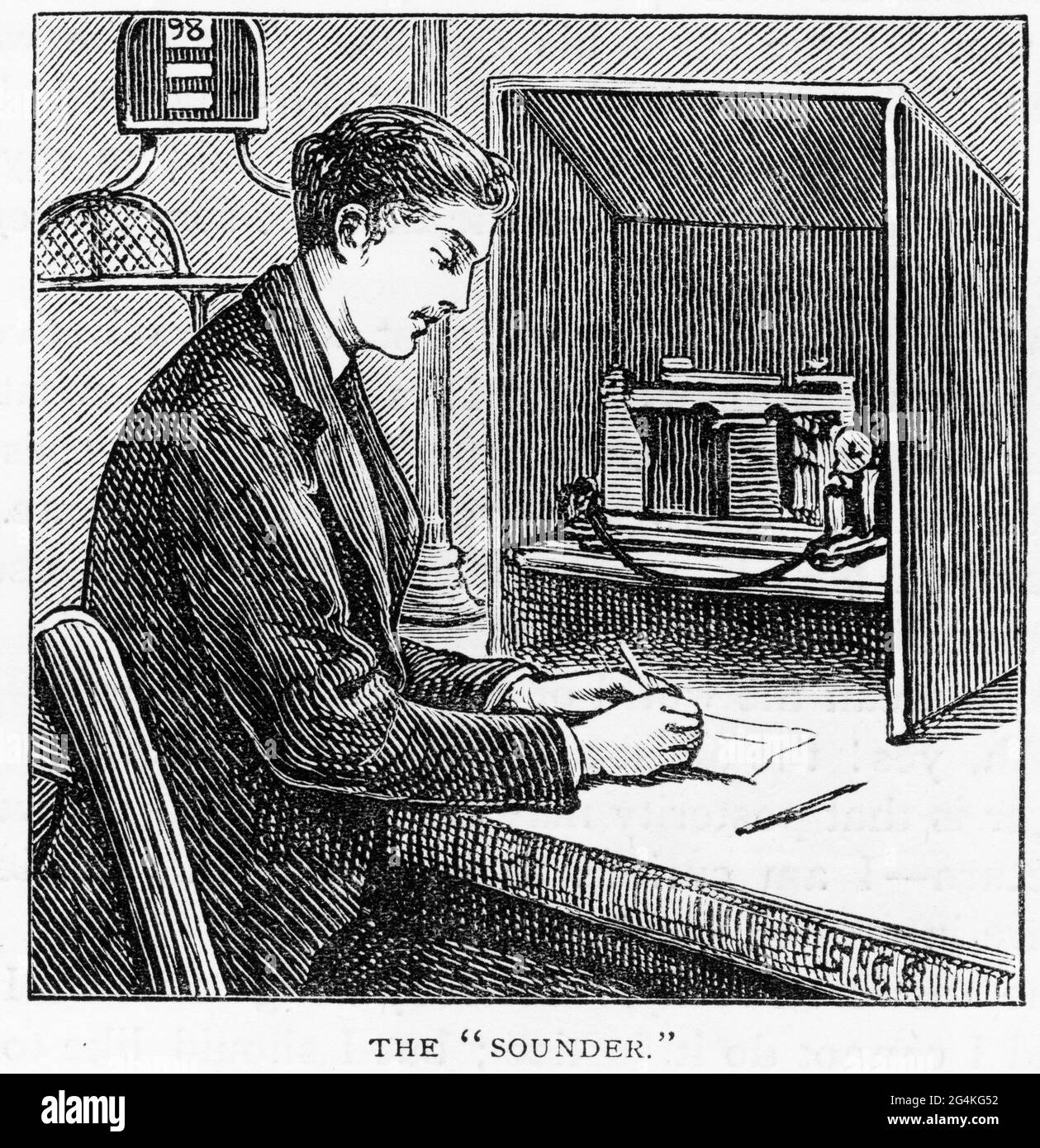 Engraving of a man receiving telegraph messages by morse code, circa 1890 Stock Photohttps://www.alamy.com/image-license-details/?v=1https://www.alamy.com/engraving-of-a-man-receiving-telegraph-messages-by-morse-code-circa-1890-image433147598.html
Engraving of a man receiving telegraph messages by morse code, circa 1890 Stock Photohttps://www.alamy.com/image-license-details/?v=1https://www.alamy.com/engraving-of-a-man-receiving-telegraph-messages-by-morse-code-circa-1890-image433147598.htmlRM2G4KG52–Engraving of a man receiving telegraph messages by morse code, circa 1890
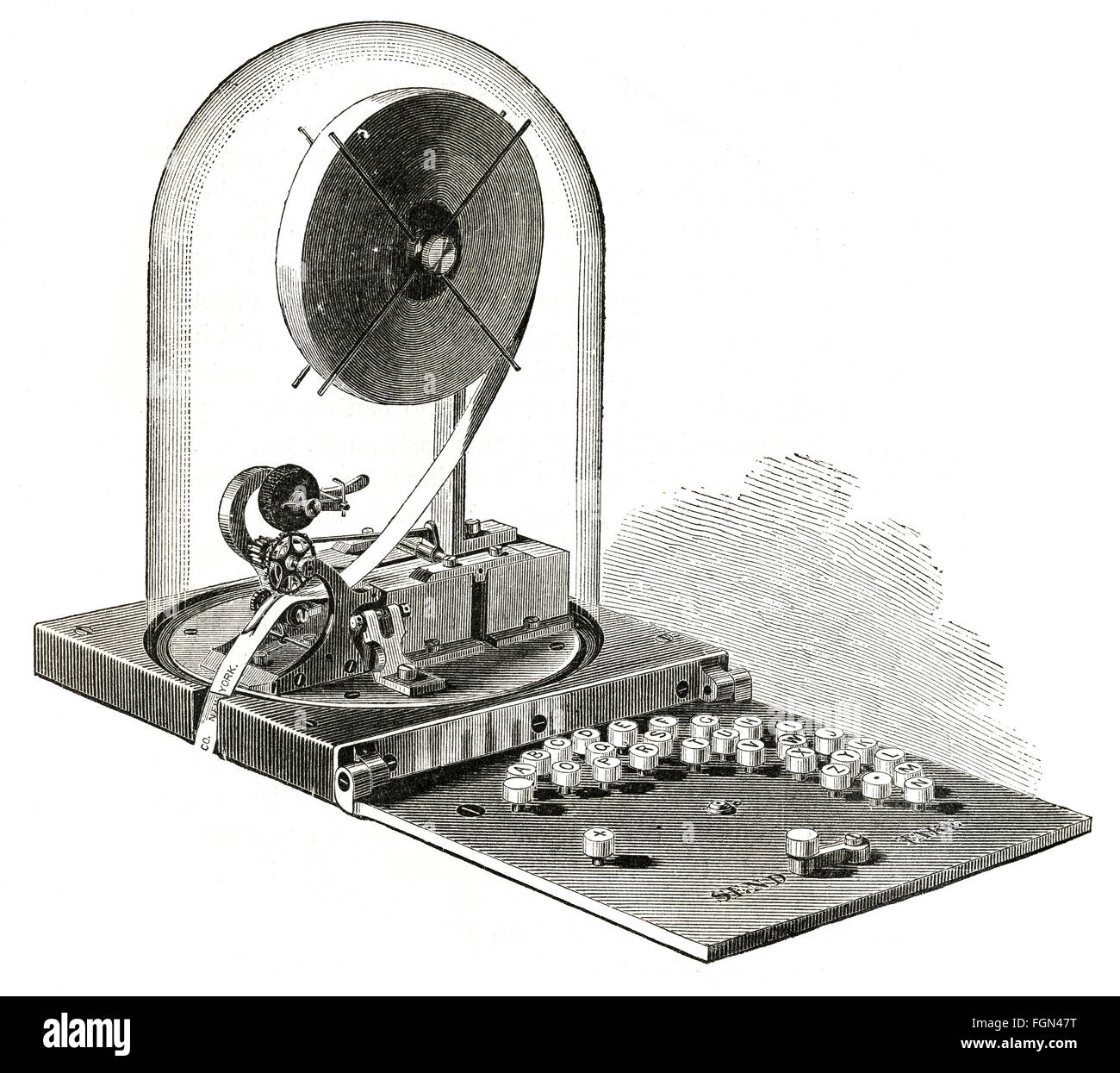 Antique 1877 engraving, George May Phelps's Printing Telegraph for Private Lines with pin keyboard configuration. Stock Photohttps://www.alamy.com/image-license-details/?v=1https://www.alamy.com/stock-photo-antique-1877-engraving-george-may-phelpss-printing-telegraph-for-private-96350684.html
Antique 1877 engraving, George May Phelps's Printing Telegraph for Private Lines with pin keyboard configuration. Stock Photohttps://www.alamy.com/image-license-details/?v=1https://www.alamy.com/stock-photo-antique-1877-engraving-george-may-phelpss-printing-telegraph-for-private-96350684.htmlRMFGN47T–Antique 1877 engraving, George May Phelps's Printing Telegraph for Private Lines with pin keyboard configuration.
 1854 engraving, House's American Printing Telegraph, with A to Z style piano keys for typing. Stock Photohttps://www.alamy.com/image-license-details/?v=1https://www.alamy.com/stock-photo-1854-engraving-houses-american-printing-telegraph-with-a-to-z-style-41805473.html
1854 engraving, House's American Printing Telegraph, with A to Z style piano keys for typing. Stock Photohttps://www.alamy.com/image-license-details/?v=1https://www.alamy.com/stock-photo-1854-engraving-houses-american-printing-telegraph-with-a-to-z-style-41805473.htmlRMCC0B8H–1854 engraving, House's American Printing Telegraph, with A to Z style piano keys for typing.
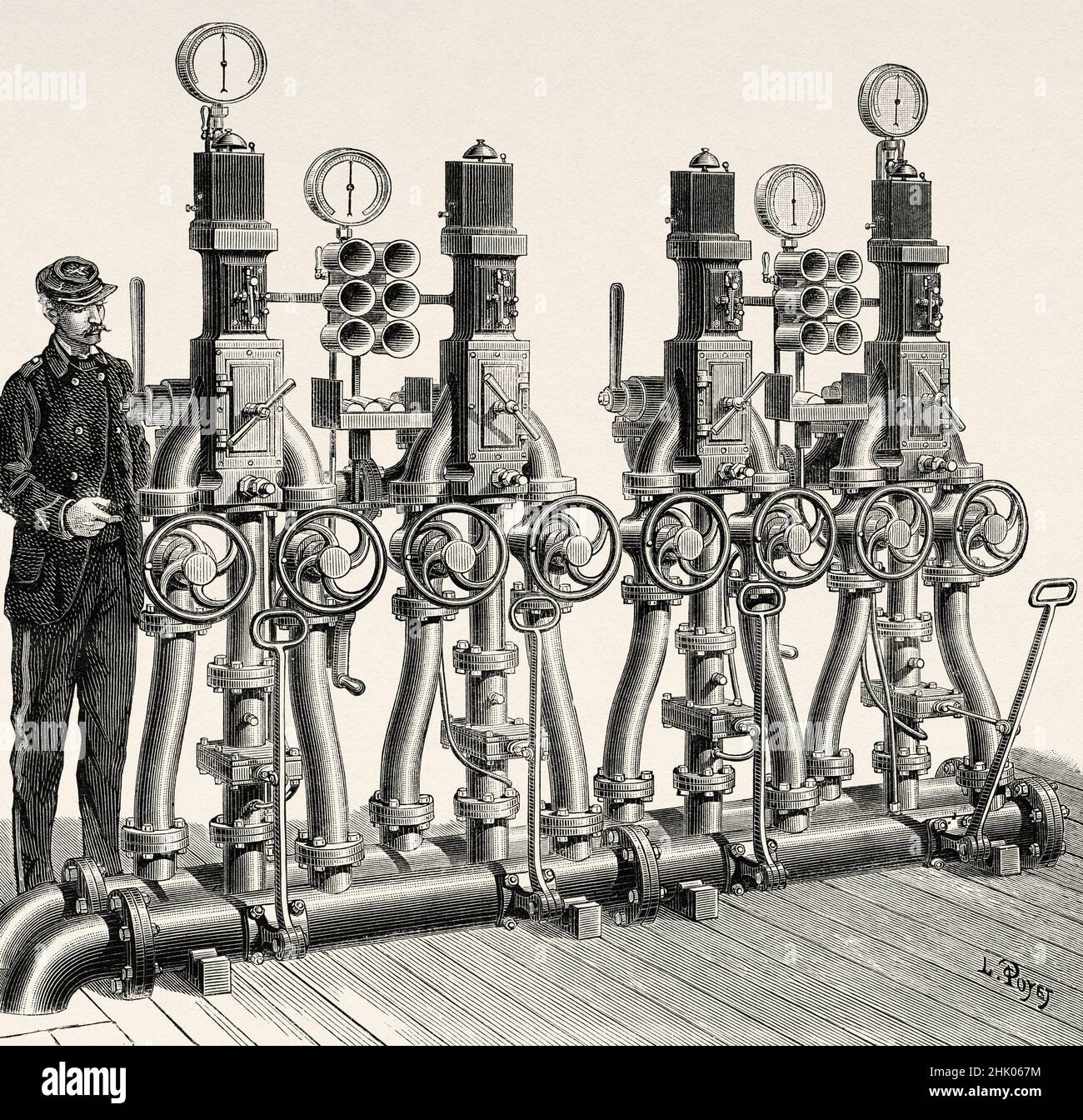 The pneumatic telegraph network, pneumatic tube system at the Central Telegraph Office in Paris, France. Europe. Old 19th century engraved illustration from La Nature 1884 Stock Photohttps://www.alamy.com/image-license-details/?v=1https://www.alamy.com/the-pneumatic-telegraph-network-pneumatic-tube-system-at-the-central-telegraph-office-in-paris-france-europe-old-19th-century-engraved-illustration-from-la-nature-1884-image459152952.html
The pneumatic telegraph network, pneumatic tube system at the Central Telegraph Office in Paris, France. Europe. Old 19th century engraved illustration from La Nature 1884 Stock Photohttps://www.alamy.com/image-license-details/?v=1https://www.alamy.com/the-pneumatic-telegraph-network-pneumatic-tube-system-at-the-central-telegraph-office-in-paris-france-europe-old-19th-century-engraved-illustration-from-la-nature-1884-image459152952.htmlRM2HK067M–The pneumatic telegraph network, pneumatic tube system at the Central Telegraph Office in Paris, France. Europe. Old 19th century engraved illustration from La Nature 1884
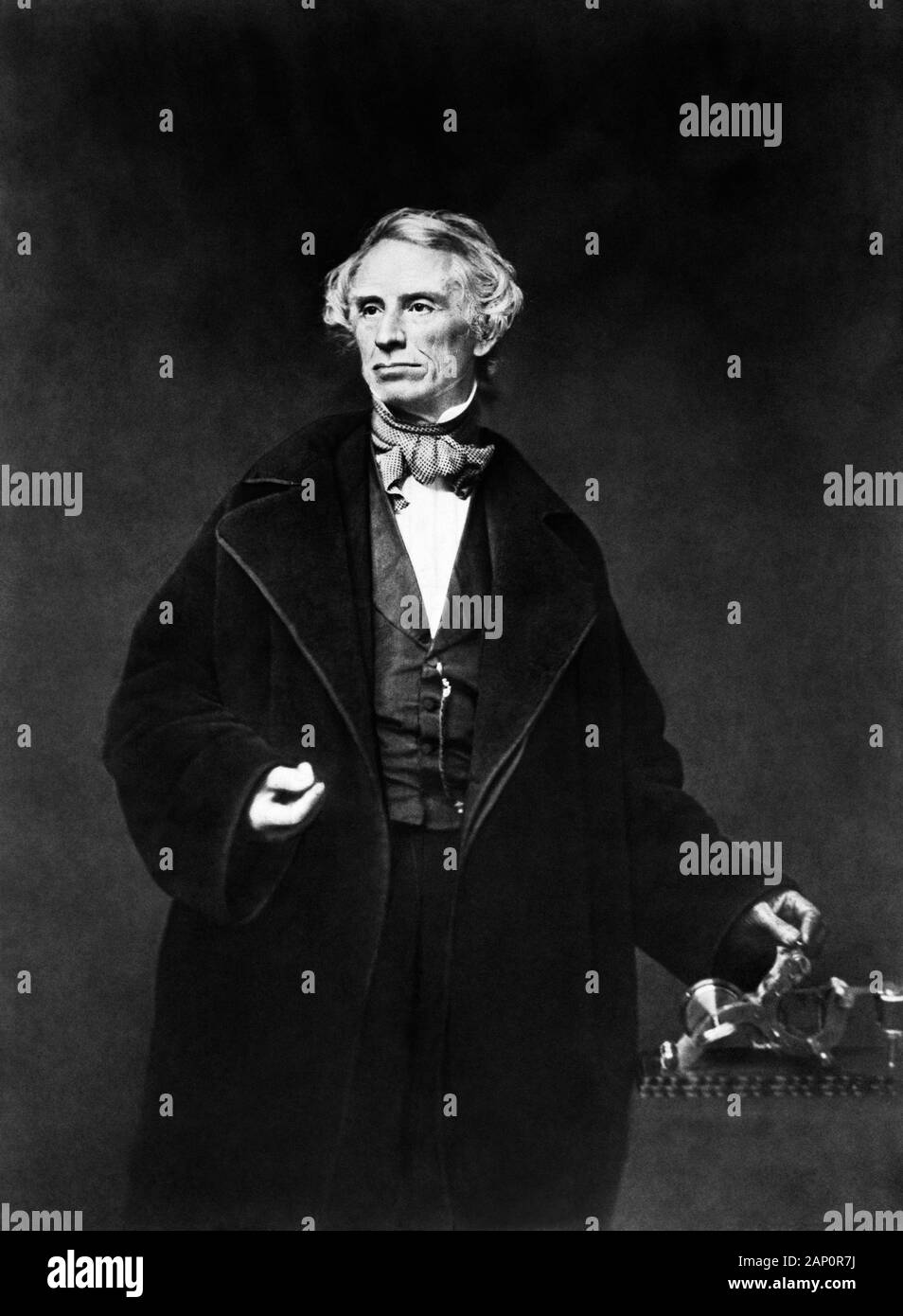 Vintage portrait photo of American painter and inventor Samuel F B Morse (1791 – 1872) – a pioneer in the development of the electric telegraph and co-creator of Morse Code. Photo circa 1855 by Mathew B Brady showing Morse with his hand on a telegraph apparatus. Stock Photohttps://www.alamy.com/image-license-details/?v=1https://www.alamy.com/vintage-portrait-photo-of-american-painter-and-inventor-samuel-f-b-morse-1791-1872-a-pioneer-in-the-development-of-the-electric-telegraph-and-co-creator-of-morse-code-photo-circa-1855-by-mathew-b-brady-showing-morse-with-his-hand-on-a-telegraph-apparatus-image340537670.html
Vintage portrait photo of American painter and inventor Samuel F B Morse (1791 – 1872) – a pioneer in the development of the electric telegraph and co-creator of Morse Code. Photo circa 1855 by Mathew B Brady showing Morse with his hand on a telegraph apparatus. Stock Photohttps://www.alamy.com/image-license-details/?v=1https://www.alamy.com/vintage-portrait-photo-of-american-painter-and-inventor-samuel-f-b-morse-1791-1872-a-pioneer-in-the-development-of-the-electric-telegraph-and-co-creator-of-morse-code-photo-circa-1855-by-mathew-b-brady-showing-morse-with-his-hand-on-a-telegraph-apparatus-image340537670.htmlRM2AP0R7J–Vintage portrait photo of American painter and inventor Samuel F B Morse (1791 – 1872) – a pioneer in the development of the electric telegraph and co-creator of Morse Code. Photo circa 1855 by Mathew B Brady showing Morse with his hand on a telegraph apparatus.
 Engraving of young women operating telegraph machines at an English post office, circa 1890 Stock Photohttps://www.alamy.com/image-license-details/?v=1https://www.alamy.com/engraving-of-young-women-operating-telegraph-machines-at-an-english-post-office-circa-1890-image433147643.html
Engraving of young women operating telegraph machines at an English post office, circa 1890 Stock Photohttps://www.alamy.com/image-license-details/?v=1https://www.alamy.com/engraving-of-young-women-operating-telegraph-machines-at-an-english-post-office-circa-1890-image433147643.htmlRM2G4KG6K–Engraving of young women operating telegraph machines at an English post office, circa 1890
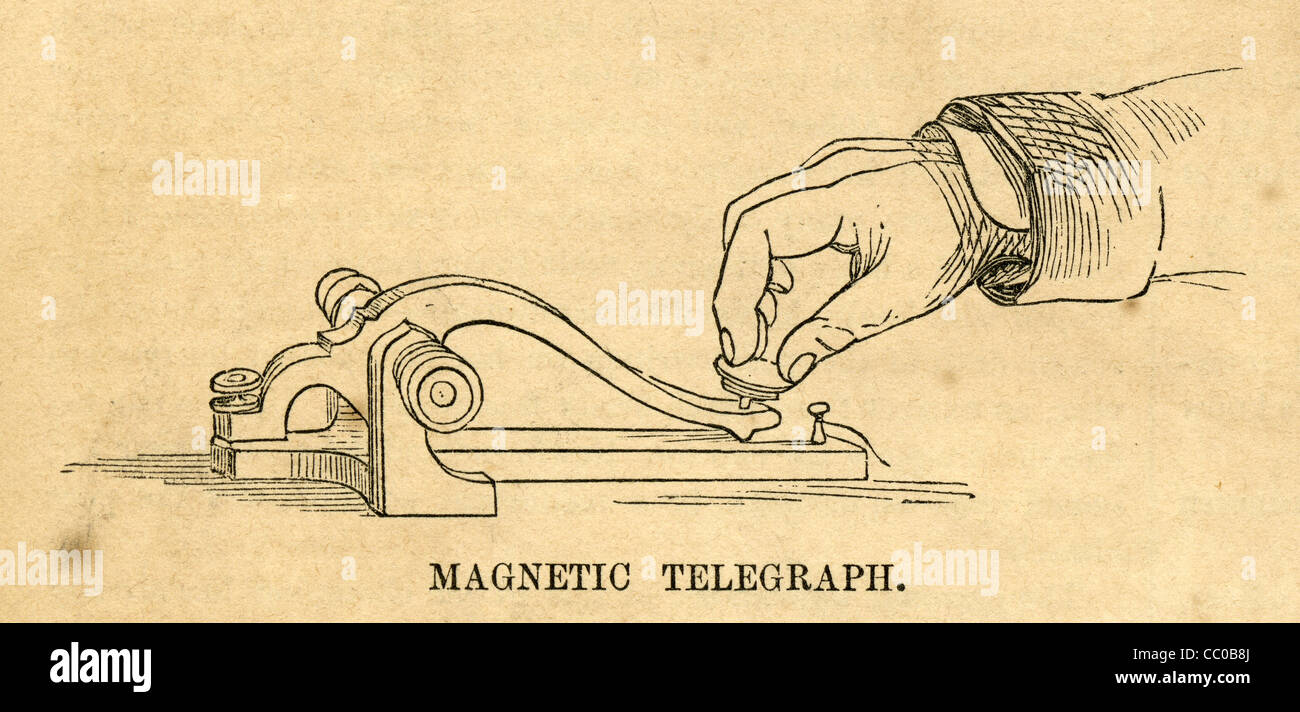 1854 engraving, Magnetic (or, Electric) Telegraph transmitter key. Stock Photohttps://www.alamy.com/image-license-details/?v=1https://www.alamy.com/stock-photo-1854-engraving-magnetic-or-electric-telegraph-transmitter-key-41805474.html
1854 engraving, Magnetic (or, Electric) Telegraph transmitter key. Stock Photohttps://www.alamy.com/image-license-details/?v=1https://www.alamy.com/stock-photo-1854-engraving-magnetic-or-electric-telegraph-transmitter-key-41805474.htmlRMCC0B8J–1854 engraving, Magnetic (or, Electric) Telegraph transmitter key.
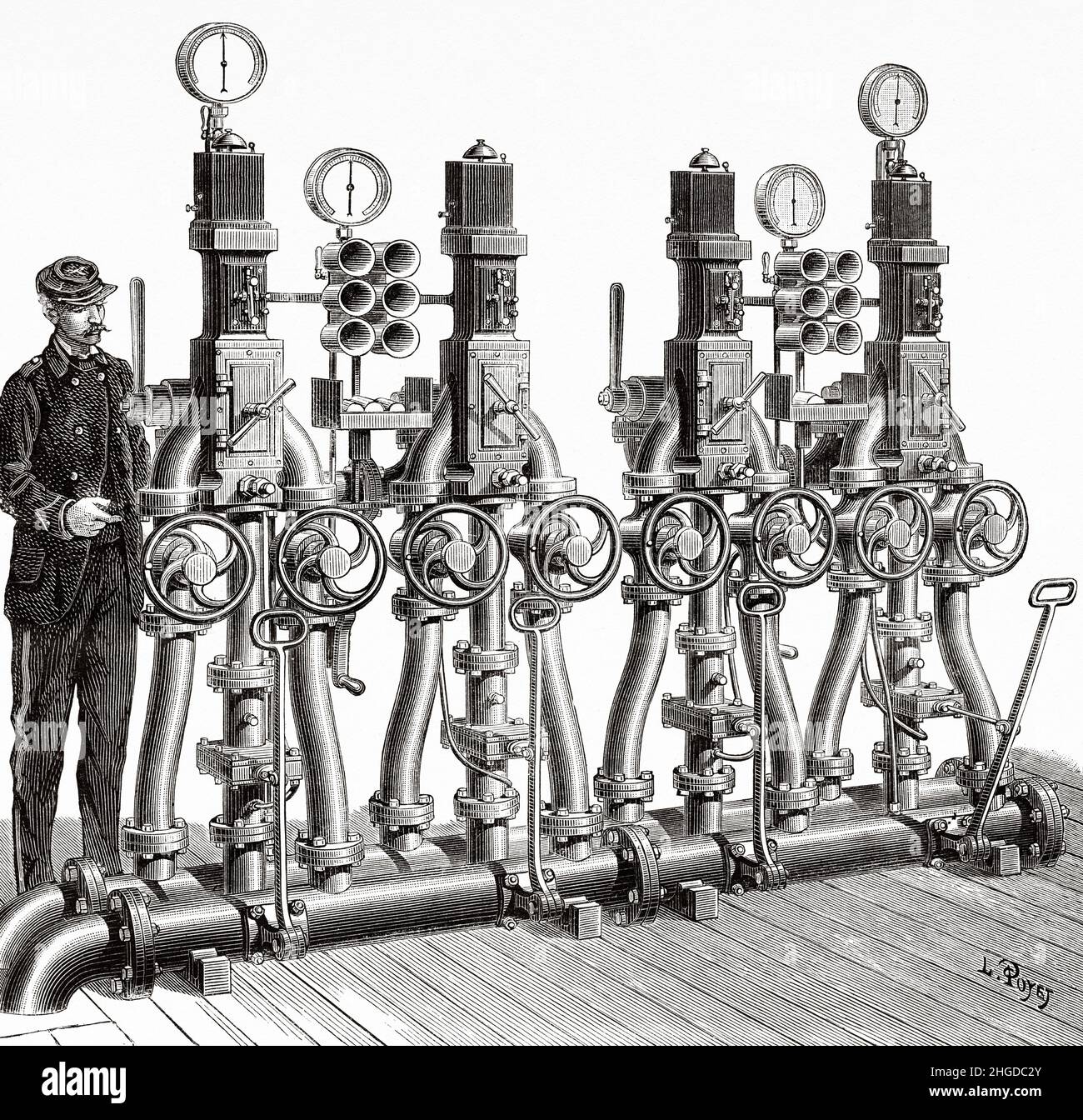 The pneumatic telegraph network, pneumatic tube system at the Central Telegraph Office in Paris, France. Europe. Old 19th century engraved illustration from La Nature 1884 Stock Photohttps://www.alamy.com/image-license-details/?v=1https://www.alamy.com/the-pneumatic-telegraph-network-pneumatic-tube-system-at-the-central-telegraph-office-in-paris-france-europe-old-19th-century-engraved-illustration-from-la-nature-1884-image457598931.html
The pneumatic telegraph network, pneumatic tube system at the Central Telegraph Office in Paris, France. Europe. Old 19th century engraved illustration from La Nature 1884 Stock Photohttps://www.alamy.com/image-license-details/?v=1https://www.alamy.com/the-pneumatic-telegraph-network-pneumatic-tube-system-at-the-central-telegraph-office-in-paris-france-europe-old-19th-century-engraved-illustration-from-la-nature-1884-image457598931.htmlRM2HGDC2Y–The pneumatic telegraph network, pneumatic tube system at the Central Telegraph Office in Paris, France. Europe. Old 19th century engraved illustration from La Nature 1884
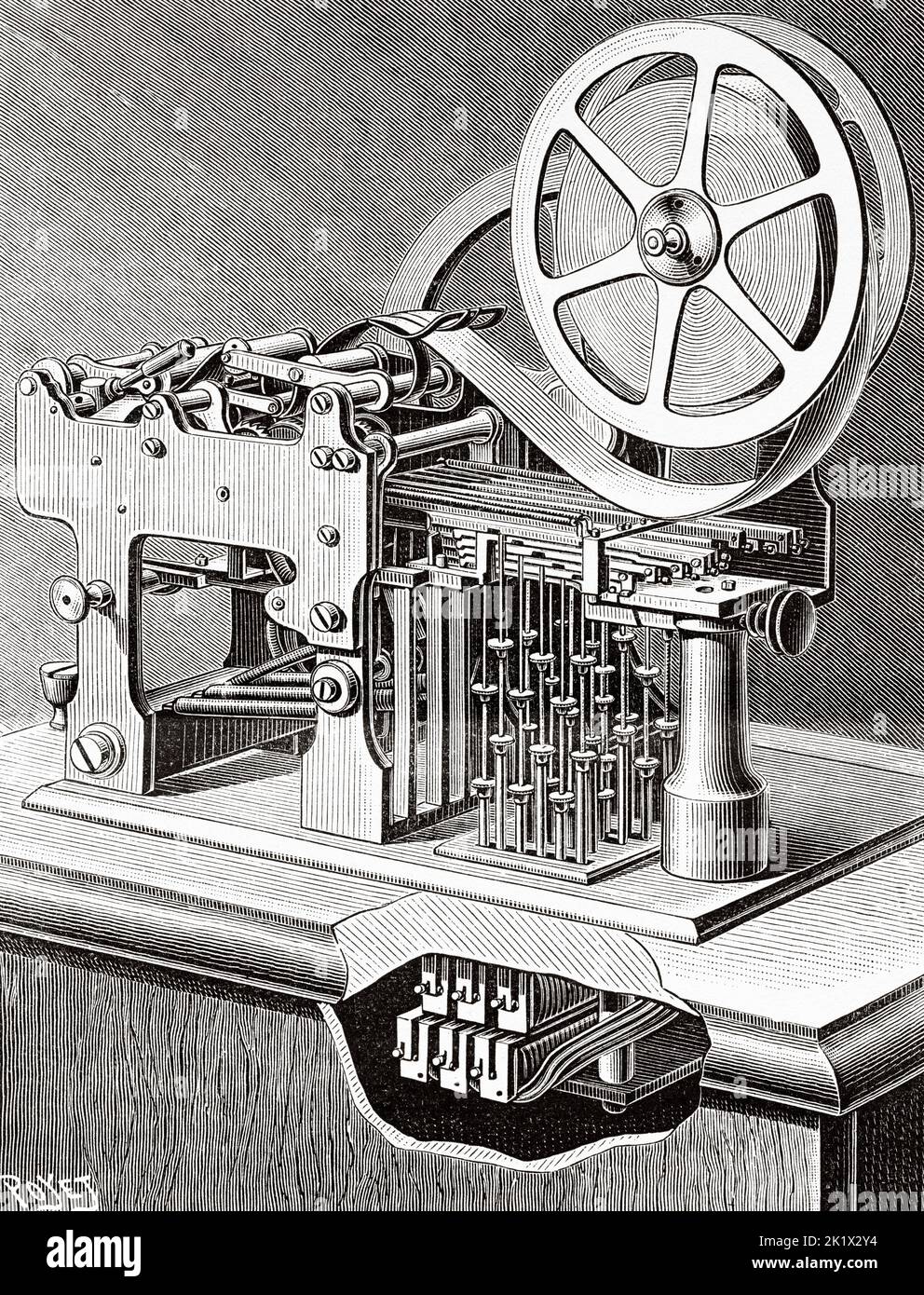 Stenotelegraph invented by Cassagnes. Old 19th century engraved illustration from La Nature 1890 Stock Photohttps://www.alamy.com/image-license-details/?v=1https://www.alamy.com/stenotelegraph-invented-by-cassagnes-old-19th-century-engraved-illustration-from-la-nature-1890-image483078040.html
Stenotelegraph invented by Cassagnes. Old 19th century engraved illustration from La Nature 1890 Stock Photohttps://www.alamy.com/image-license-details/?v=1https://www.alamy.com/stenotelegraph-invented-by-cassagnes-old-19th-century-engraved-illustration-from-la-nature-1890-image483078040.htmlRM2K1X2Y4–Stenotelegraph invented by Cassagnes. Old 19th century engraved illustration from La Nature 1890
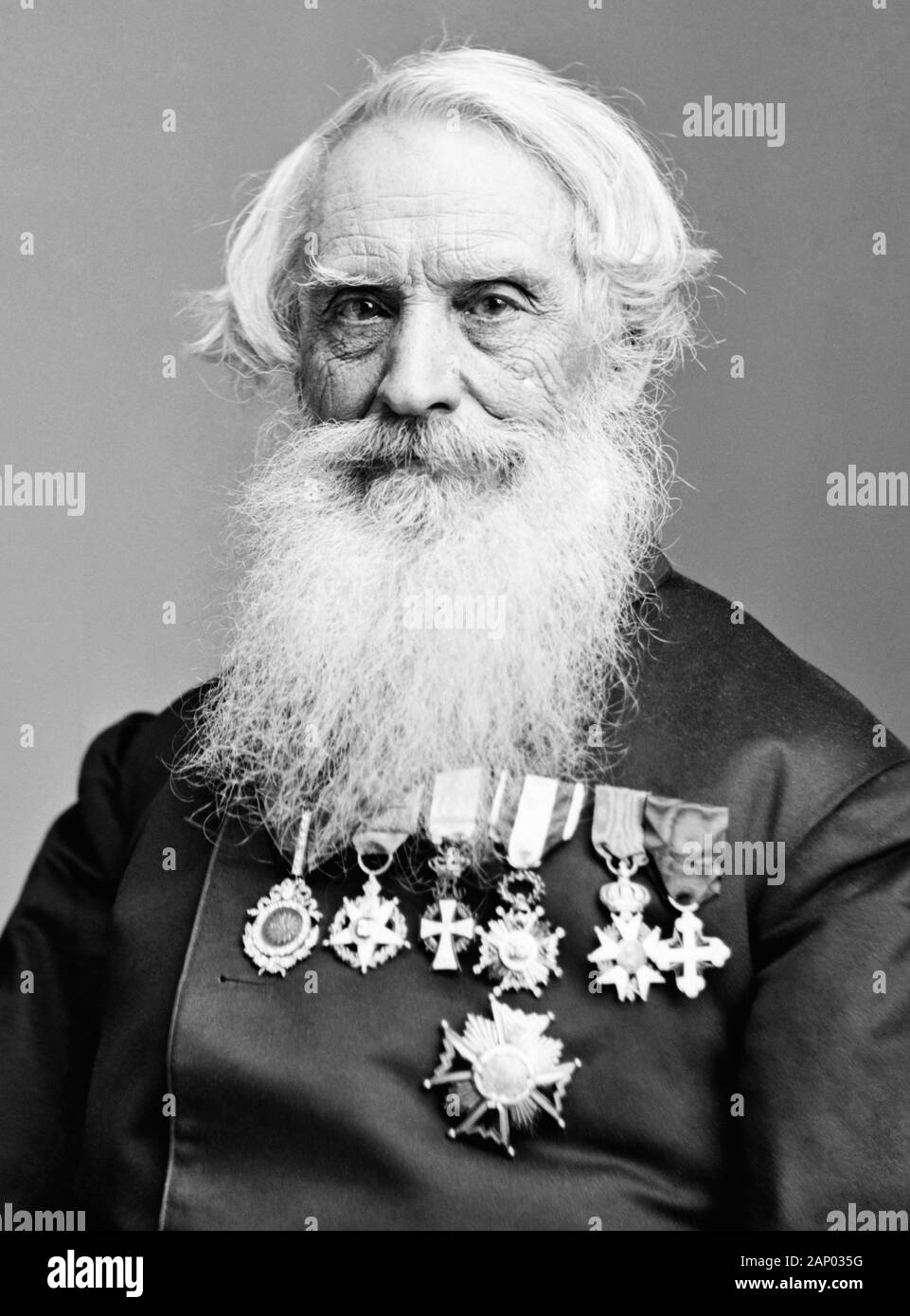 Vintage portrait photo of American painter and inventor Samuel F B Morse (1791 – 1872) – a pioneer in the development of the electric telegraph and co-creator of Morse Code. Photo circa 1865 by Brady – Handy showing Morse wearing medals awarded to him by various countries in recognition of his achievements. Stock Photohttps://www.alamy.com/image-license-details/?v=1https://www.alamy.com/vintage-portrait-photo-of-american-painter-and-inventor-samuel-f-b-morse-1791-1872-a-pioneer-in-the-development-of-the-electric-telegraph-and-co-creator-of-morse-code-photo-circa-1865-by-brady-handy-showing-morse-wearing-medals-awarded-to-him-by-various-countries-in-recognition-of-his-achievements-image340521932.html
Vintage portrait photo of American painter and inventor Samuel F B Morse (1791 – 1872) – a pioneer in the development of the electric telegraph and co-creator of Morse Code. Photo circa 1865 by Brady – Handy showing Morse wearing medals awarded to him by various countries in recognition of his achievements. Stock Photohttps://www.alamy.com/image-license-details/?v=1https://www.alamy.com/vintage-portrait-photo-of-american-painter-and-inventor-samuel-f-b-morse-1791-1872-a-pioneer-in-the-development-of-the-electric-telegraph-and-co-creator-of-morse-code-photo-circa-1865-by-brady-handy-showing-morse-wearing-medals-awarded-to-him-by-various-countries-in-recognition-of-his-achievements-image340521932.htmlRM2AP035G–Vintage portrait photo of American painter and inventor Samuel F B Morse (1791 – 1872) – a pioneer in the development of the electric telegraph and co-creator of Morse Code. Photo circa 1865 by Brady – Handy showing Morse wearing medals awarded to him by various countries in recognition of his achievements.
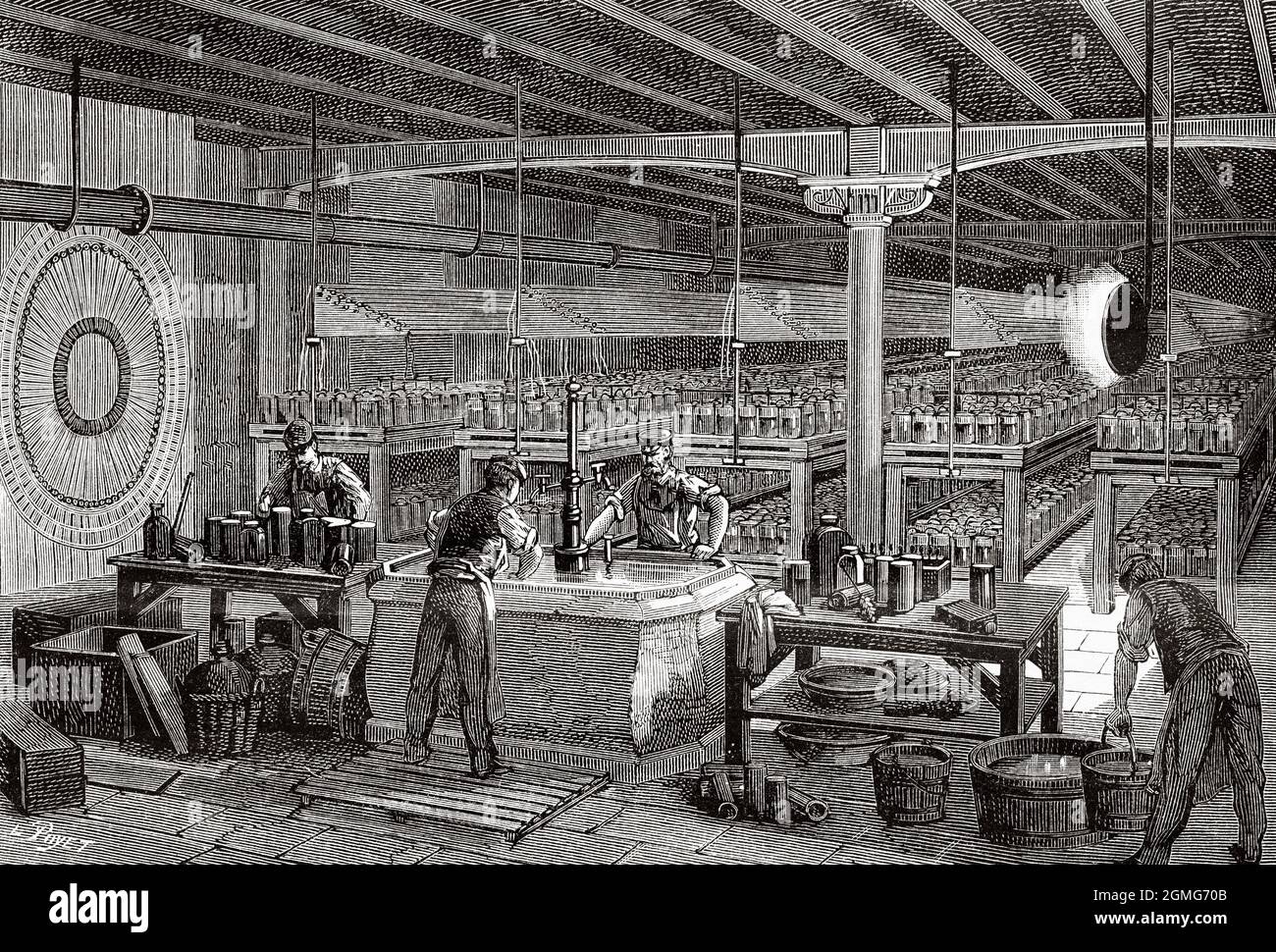 The battery room at the central office of telegraphs in Paris, France. Europe. Old 19th century engraved illustration from La Nature 1883 Stock Photohttps://www.alamy.com/image-license-details/?v=1https://www.alamy.com/the-battery-room-at-the-central-office-of-telegraphs-in-paris-france-europe-old-19th-century-engraved-illustration-from-la-nature-1883-image442909051.html
The battery room at the central office of telegraphs in Paris, France. Europe. Old 19th century engraved illustration from La Nature 1883 Stock Photohttps://www.alamy.com/image-license-details/?v=1https://www.alamy.com/the-battery-room-at-the-central-office-of-telegraphs-in-paris-france-europe-old-19th-century-engraved-illustration-from-la-nature-1883-image442909051.htmlRM2GMG70B–The battery room at the central office of telegraphs in Paris, France. Europe. Old 19th century engraved illustration from La Nature 1883
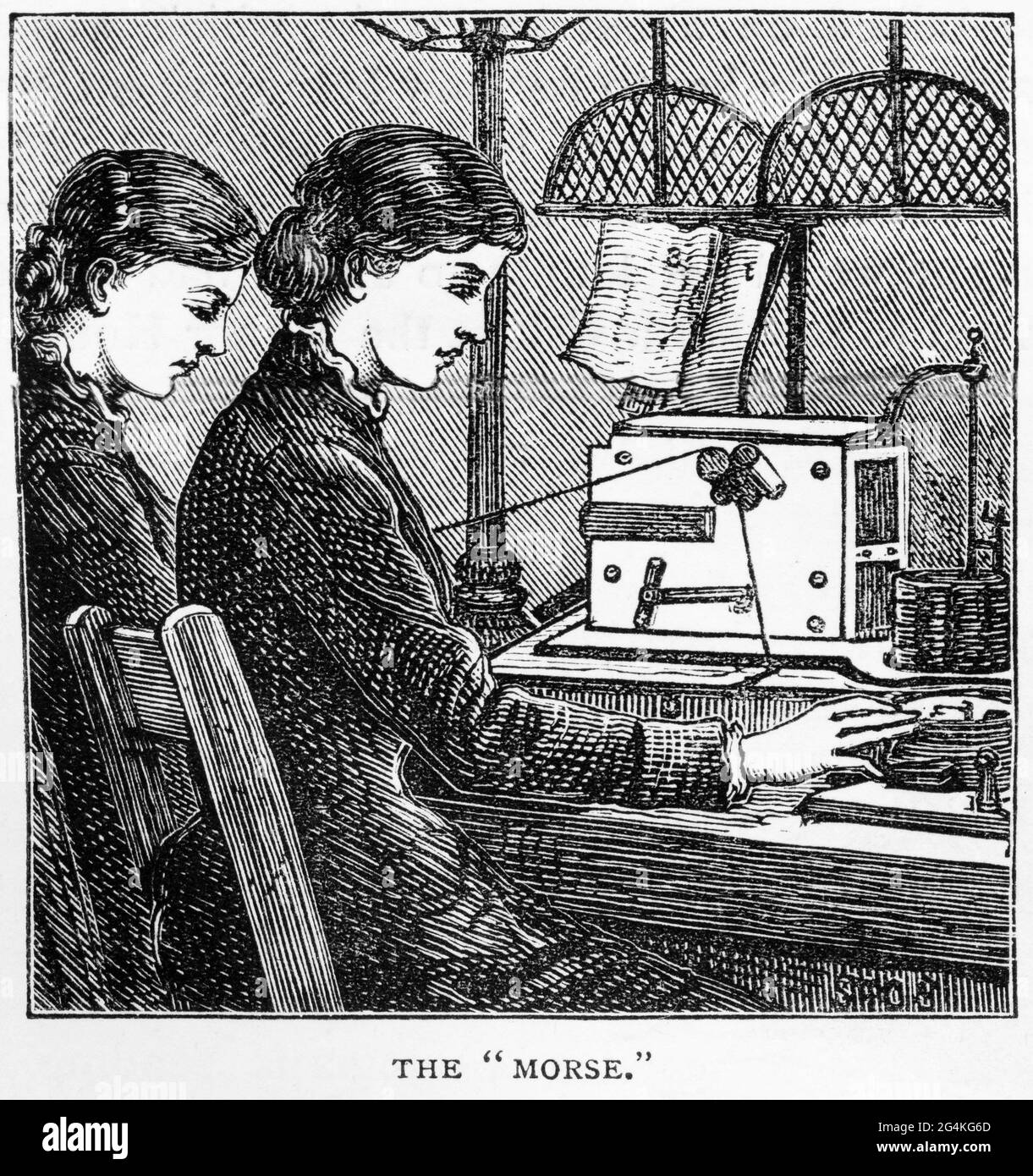 Engraving of young women operating telegraph machines and receiving morse code messages at an English post office, circa 1890 Stock Photohttps://www.alamy.com/image-license-details/?v=1https://www.alamy.com/engraving-of-young-women-operating-telegraph-machines-and-receiving-morse-code-messages-at-an-english-post-office-circa-1890-image433147637.html
Engraving of young women operating telegraph machines and receiving morse code messages at an English post office, circa 1890 Stock Photohttps://www.alamy.com/image-license-details/?v=1https://www.alamy.com/engraving-of-young-women-operating-telegraph-machines-and-receiving-morse-code-messages-at-an-english-post-office-circa-1890-image433147637.htmlRM2G4KG6D–Engraving of young women operating telegraph machines and receiving morse code messages at an English post office, circa 1890
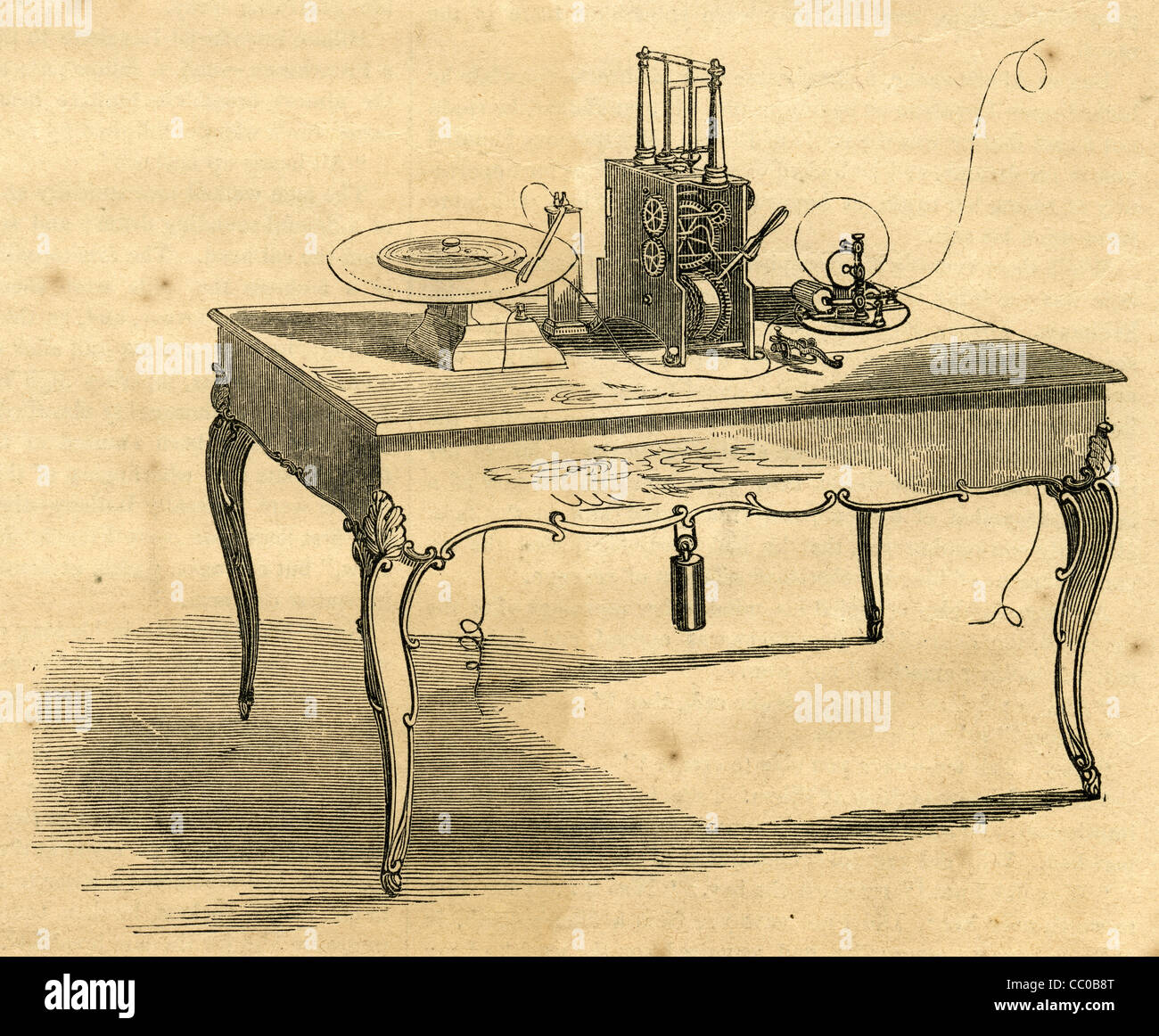 1854 engraving, Merchants' Telegraph. Stock Photohttps://www.alamy.com/image-license-details/?v=1https://www.alamy.com/stock-photo-1854-engraving-merchants-telegraph-41805480.html
1854 engraving, Merchants' Telegraph. Stock Photohttps://www.alamy.com/image-license-details/?v=1https://www.alamy.com/stock-photo-1854-engraving-merchants-telegraph-41805480.htmlRMCC0B8T–1854 engraving, Merchants' Telegraph.
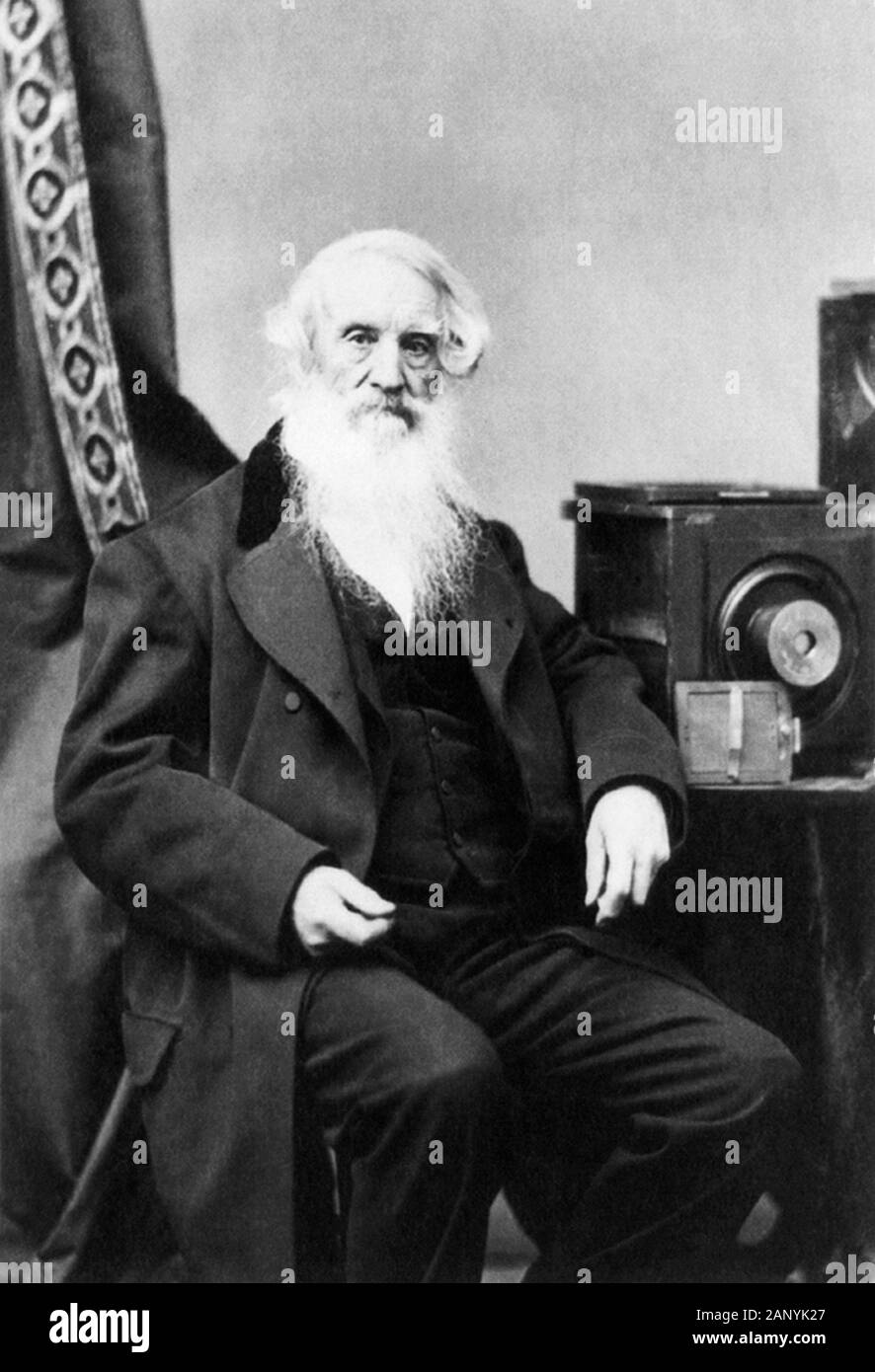 Vintage portrait photo of American painter and inventor Samuel F B Morse (1791 – 1872) – a pioneer in the development of the electric telegraph and co-creator of Morse Code. Photo circa 1872 by Abraham Bogardus of New York showing Morse seated next to a camera and glass plate negatives. Stock Photohttps://www.alamy.com/image-license-details/?v=1https://www.alamy.com/vintage-portrait-photo-of-american-painter-and-inventor-samuel-f-b-morse-1791-1872-a-pioneer-in-the-development-of-the-electric-telegraph-and-co-creator-of-morse-code-photo-circa-1872-by-abraham-bogardus-of-new-york-showing-morse-seated-next-to-a-camera-and-glass-plate-negatives-image340512431.html
Vintage portrait photo of American painter and inventor Samuel F B Morse (1791 – 1872) – a pioneer in the development of the electric telegraph and co-creator of Morse Code. Photo circa 1872 by Abraham Bogardus of New York showing Morse seated next to a camera and glass plate negatives. Stock Photohttps://www.alamy.com/image-license-details/?v=1https://www.alamy.com/vintage-portrait-photo-of-american-painter-and-inventor-samuel-f-b-morse-1791-1872-a-pioneer-in-the-development-of-the-electric-telegraph-and-co-creator-of-morse-code-photo-circa-1872-by-abraham-bogardus-of-new-york-showing-morse-seated-next-to-a-camera-and-glass-plate-negatives-image340512431.htmlRM2ANYK27–Vintage portrait photo of American painter and inventor Samuel F B Morse (1791 – 1872) – a pioneer in the development of the electric telegraph and co-creator of Morse Code. Photo circa 1872 by Abraham Bogardus of New York showing Morse seated next to a camera and glass plate negatives.
